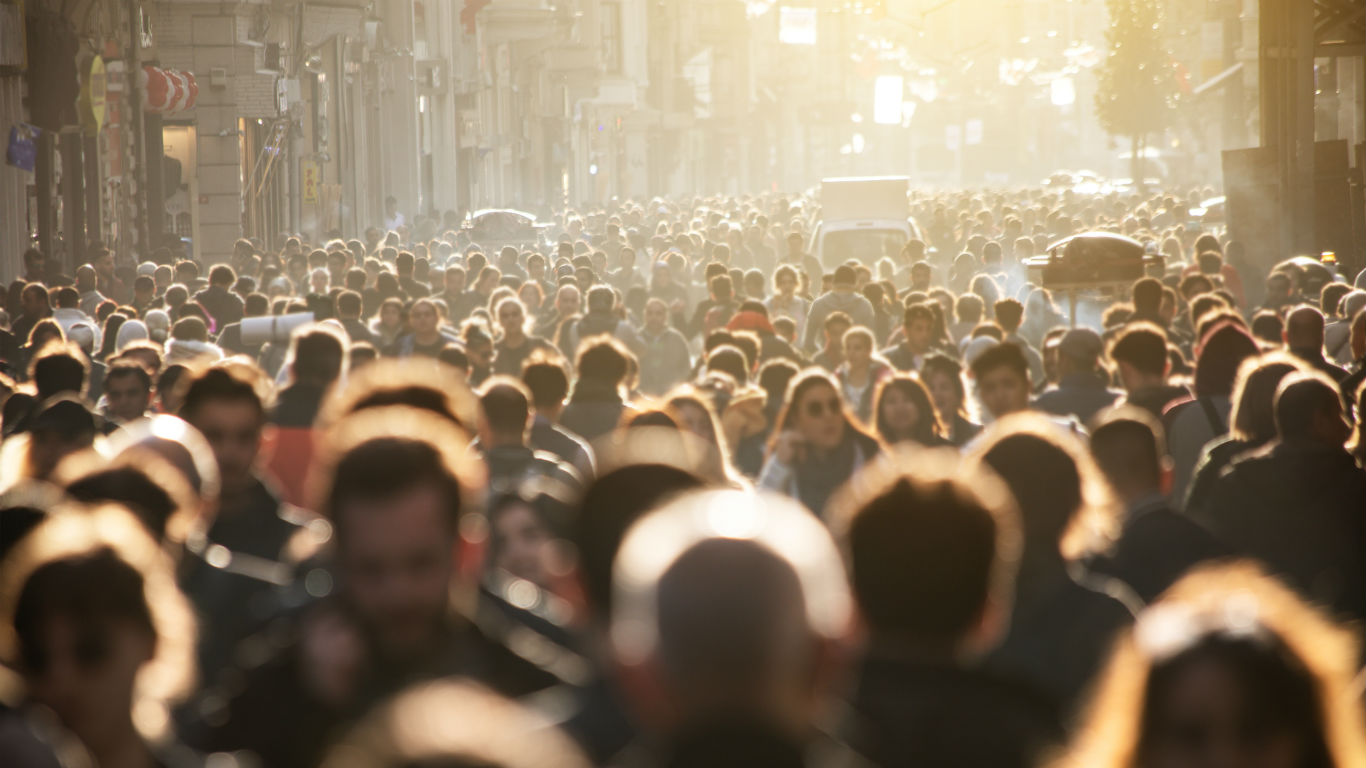
Americans living in big cities like New York or Los Angeles are familiar with the stress of overcrowded streets and sidewalks and the lack of parking. It’s nearly impossible to find a spot to spread your beach blanket at Coney Island in the summer, and the long wait to cross the George Washington bridge connecting Manhattan with the borough of Fort Lee in New Jersey should be a crime.
But take a look at the crowds from another perspective: In the United States, we don’t actually know anything about real overcrowding — not a single American city ranks among the top 50 most densely populated urban areas in the world. At the other end of the spectrum, these are the least densely populated places in the world.
A variety of factors help explain the high density of these cities, where it seems impossible to walk without bumping into pedestrians every second: more births than deaths, people moving to cities for jobs or forced off rural land by natural disasters, skyrocketing land prices, to name a few.
Population density is determined by the number of residents who live within a given land area — usually a mile or kilometer. According to the United Nations, as of 2016, about 55% of the world’s population lives in urban areas. This is expected to grow to 60% by 2030, with one in three people living in cosmopolises with at least 500,000 residents — maybe in some of the world’s 33 megacities.
In time for the World Population Day, marked every year on July 11 to raise awareness about urgent population issues, 24/7 Tempo identified the most densely populated cities in the world, using data from CityMayors Statistics, a global source for urban statistics.
Click here to read about the 50 most densely populated cities in the world.

50. Tokyo/Yokohama, Japan
> Population density: 12,296 per square mile
> Population: 33,200,000
> Square miles: 2,700 miles
Tokyo is the capital of Japan, and people flock to the city since it is the country’s political and business center. In addition to the many workers who call the region home, there is a thriving student population, thanks to more than a dozen internationally ranked universities. Young people move to Tokyo to further their education, and stay for the available internships and jobs. Despite the crowds, the quality of life earns high marks for safety, public transportation, leisure activities and culture.
[in-text-ad]
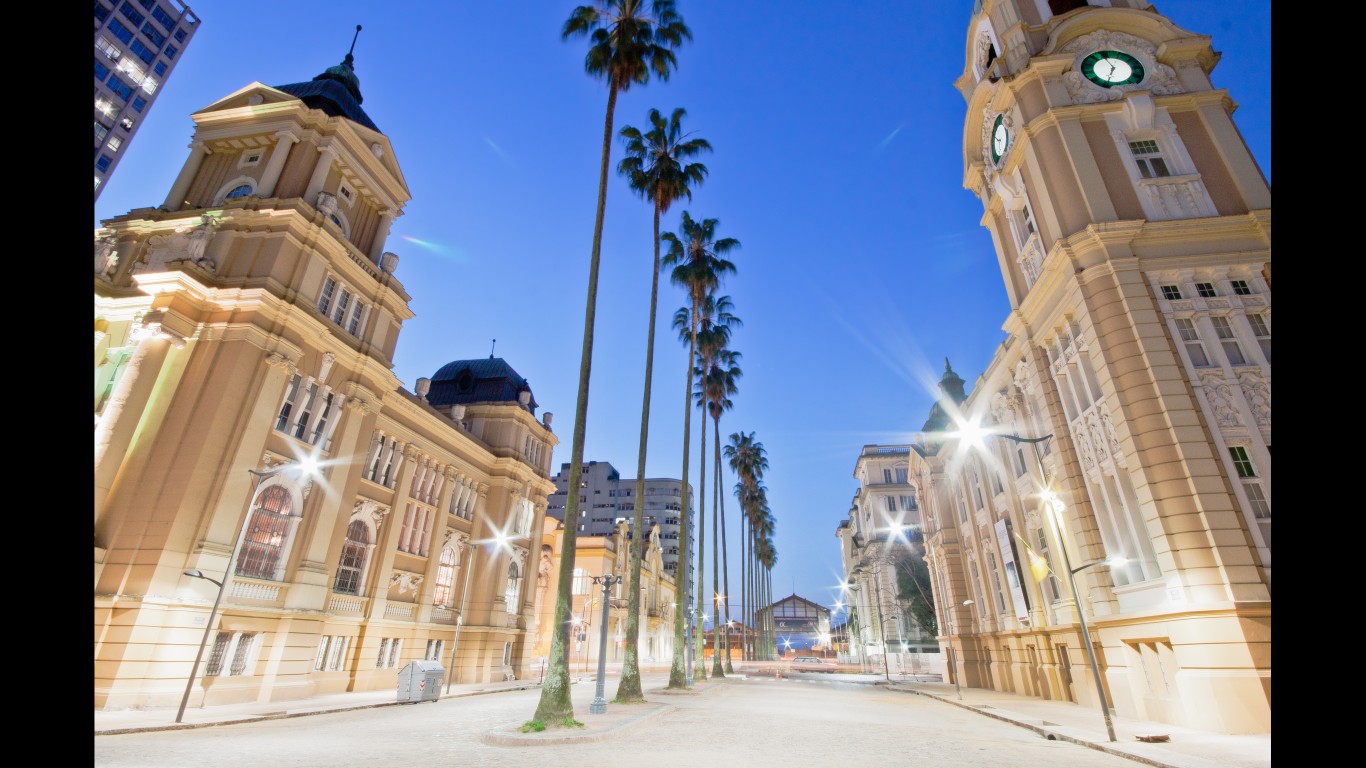
49. Porto Alegre, Brazil
> Population density: 12,439 per square mile
> Population: 2,800,000
> Square miles: 225 miles
Porto Alegre, the capital of the southern state of Rio Grande do Sul, is one of four Brazilian cities among the 50 most densely populated metro areas. It is one of the nation’s top regions for commerce and industry, as well as education and finance. As the name suggests, it has a busy port, plus jobs in tech, agriculture, manufacturing and more.

48. Barcelona, Spain
> Population density: 12,579 per square mile
> Population: 3,900,000
> Square miles: 310 miles
Barcelona isn’t too far behind Madrid when it comes to Spanish cities with the greatest population density. The capital of Catalonia is a beloved destination for tourists, with an estimated 30 million-plus visitors taking to Barcelona’s beaches, streets and cultural sites in 2017. Though the out-of-towners pump billions of euros into the local economy, some residents, including elected officials, are declaring a strong preference for refugees over tourists, noting that migrants become part of the community, while short-term visitors destabilize it.
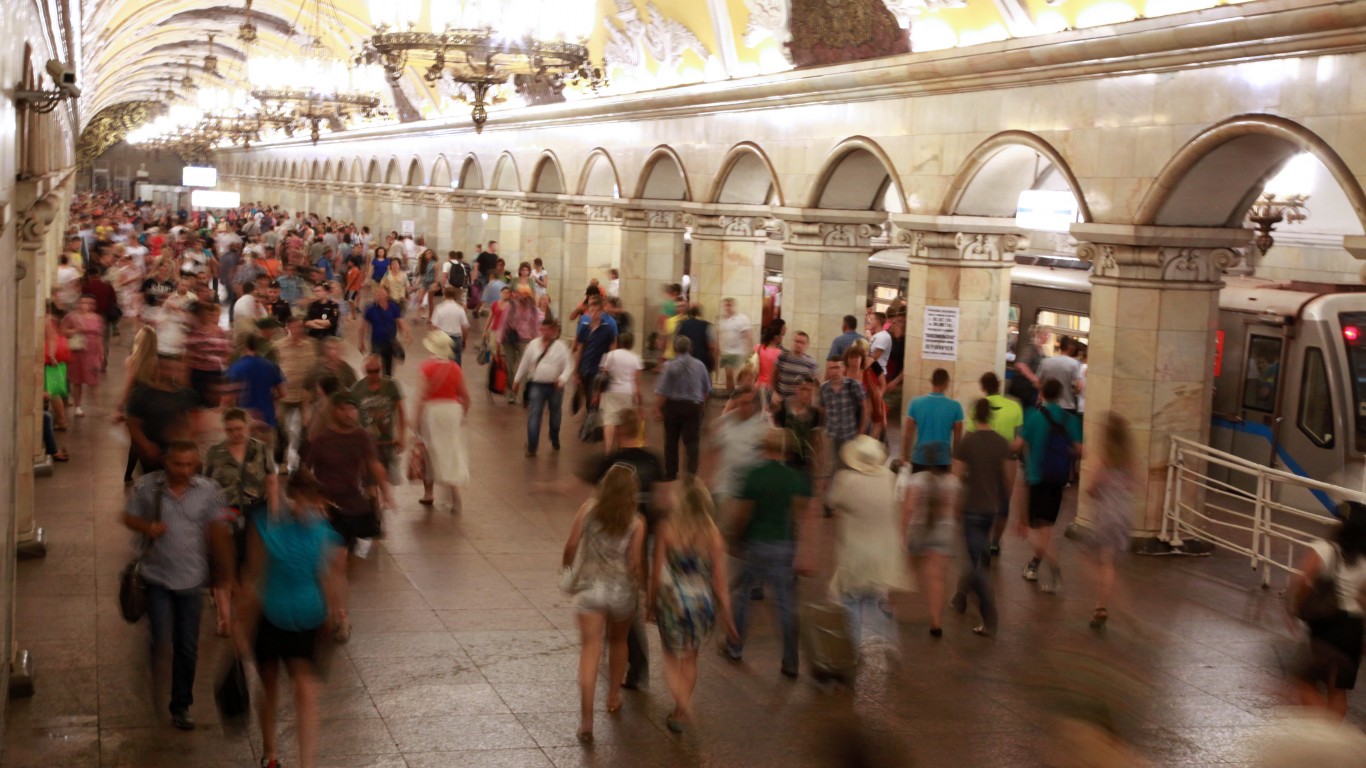
47. Moscow, Russia
> Population density: 12,649 per square mile
> Population: 10,500,000
> Square miles: 830 miles
The largest country on Earth by area, Russia’s overall population density is a mere 23 people per square mile when you take all of that vast space into consideration. But the headcount density is radically different in the crush of the capital city, where more than 12,000 people share each square mile. Moscow is the northern-most megacity on the planet, and also the coldest. It has one of Europe’s largest economies, and low living costs compared to other major cities.
[in-text-ad-2]
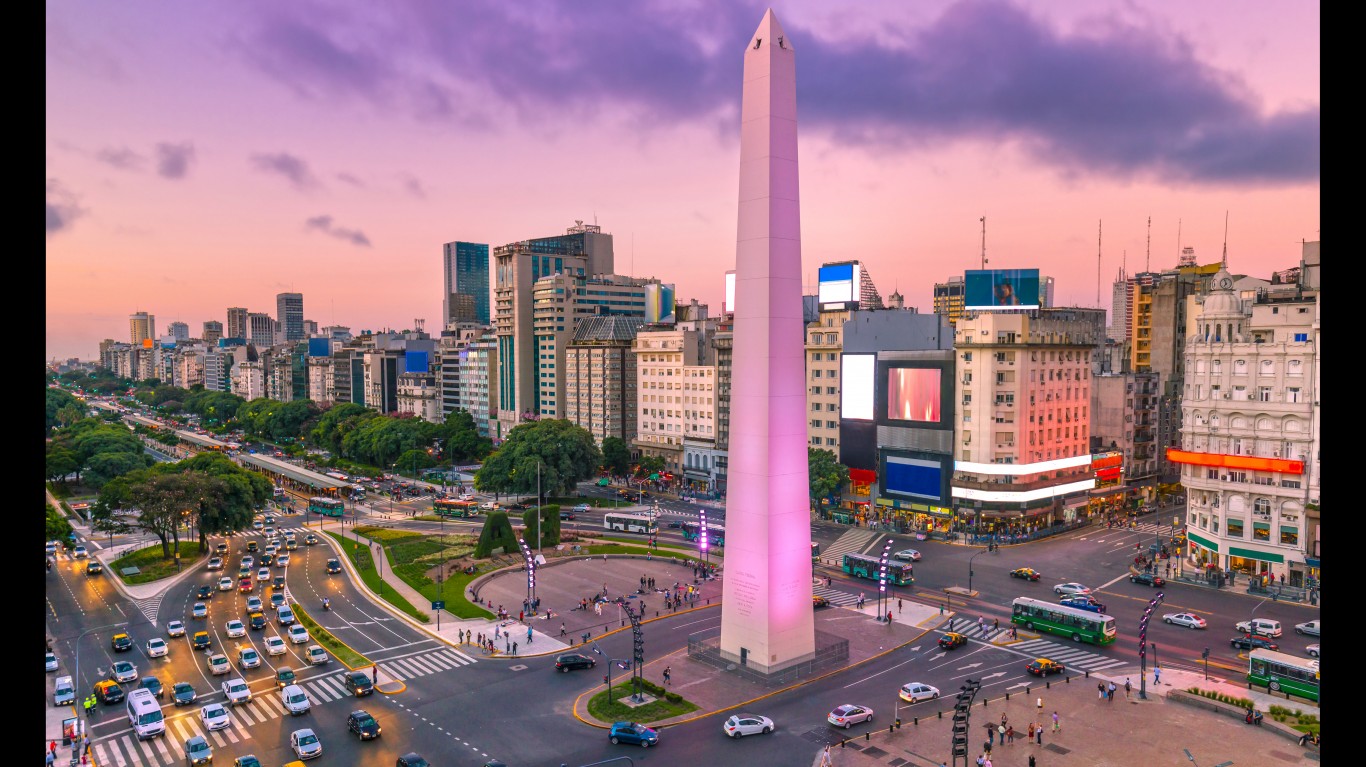
46. Buenos Aires, Argentina
> Population density: 12,801 per square mile
> Population: 11,200,000
> Square miles: 875 miles
Argentina’s capital city is among the world’s busiest ports; its varied economy includes government, commerce, industry, technology and culture. Agriculture, including grain exports, is among the leading businesses, with the Buenos Aires province being one of the top 10 wheat producers on Earth; the world’s largest livestock market is located in the capital city.
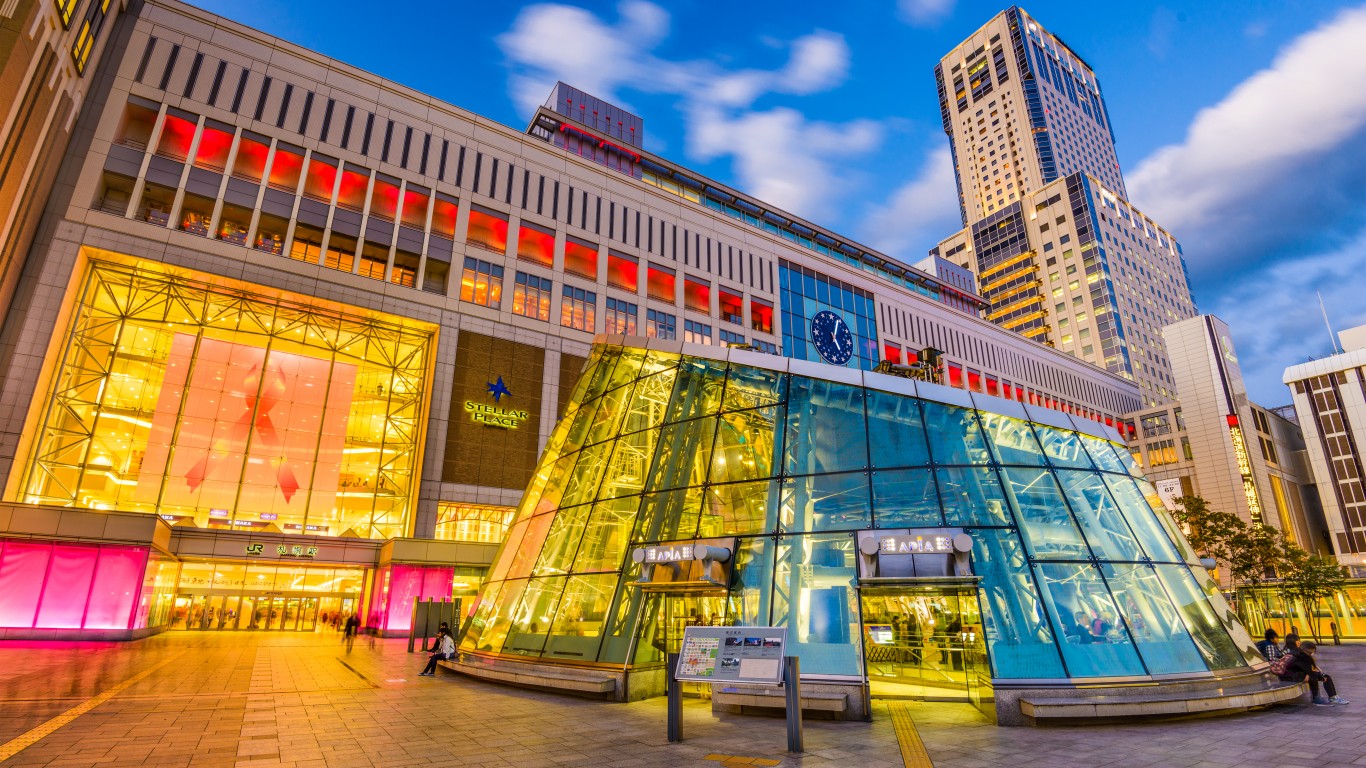
45. Sapporo, Japan
> Population density: 12,981 per square mile
> Population: 2,075,000
> Square miles: 160 miles
Even though there’s not much elbow room around Sapporo, the megapolis shows high potential for renewable energy development. One of three Japanese areas among the 50 most densely populated places on Earth, Sapporo is the capital of the Hokkaido prefecture. It has a thriving international port, well-regarded universities and research institutes, IT industry, and a cool factor due to its recognition as the first Asian city chosen as a member of the UNESCO Creative Cities Network in the field of media and arts.
[in-text-ad]
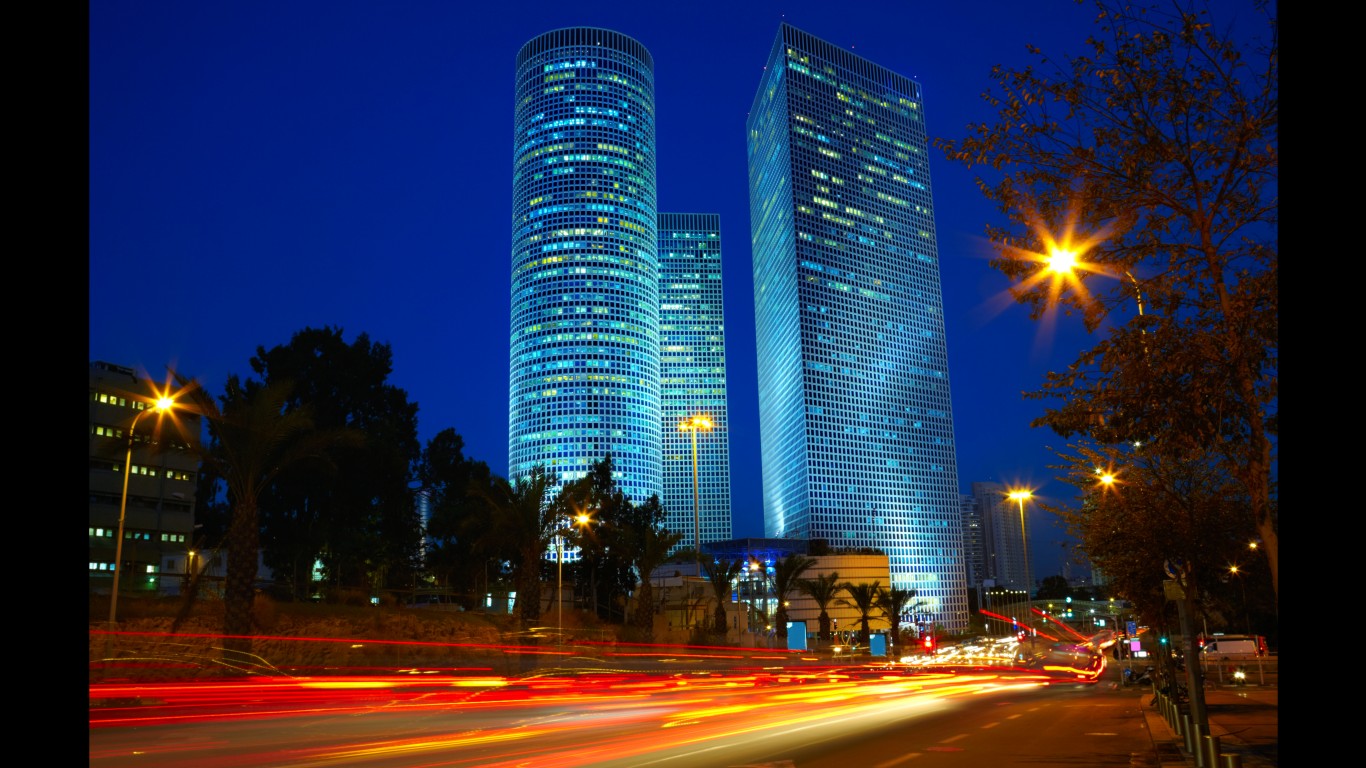
44. Tel Aviv, Israel
> Population density: 13,150 per square mile
> Population: 2,300,000
> Square miles: 175 miles
The second largest city in Israel, Tel Aviv is the country’s top destination for new immigrants from the United States, Africa, Russia, Ukraine and elsewhere. While some gravitate to the city for religious reasons or for asylum, others are attracted by the booming economy and business opportunities. Tel Aviv leads the world in the number of per capita startups, and has the highest gross domestic product investment in research and development.
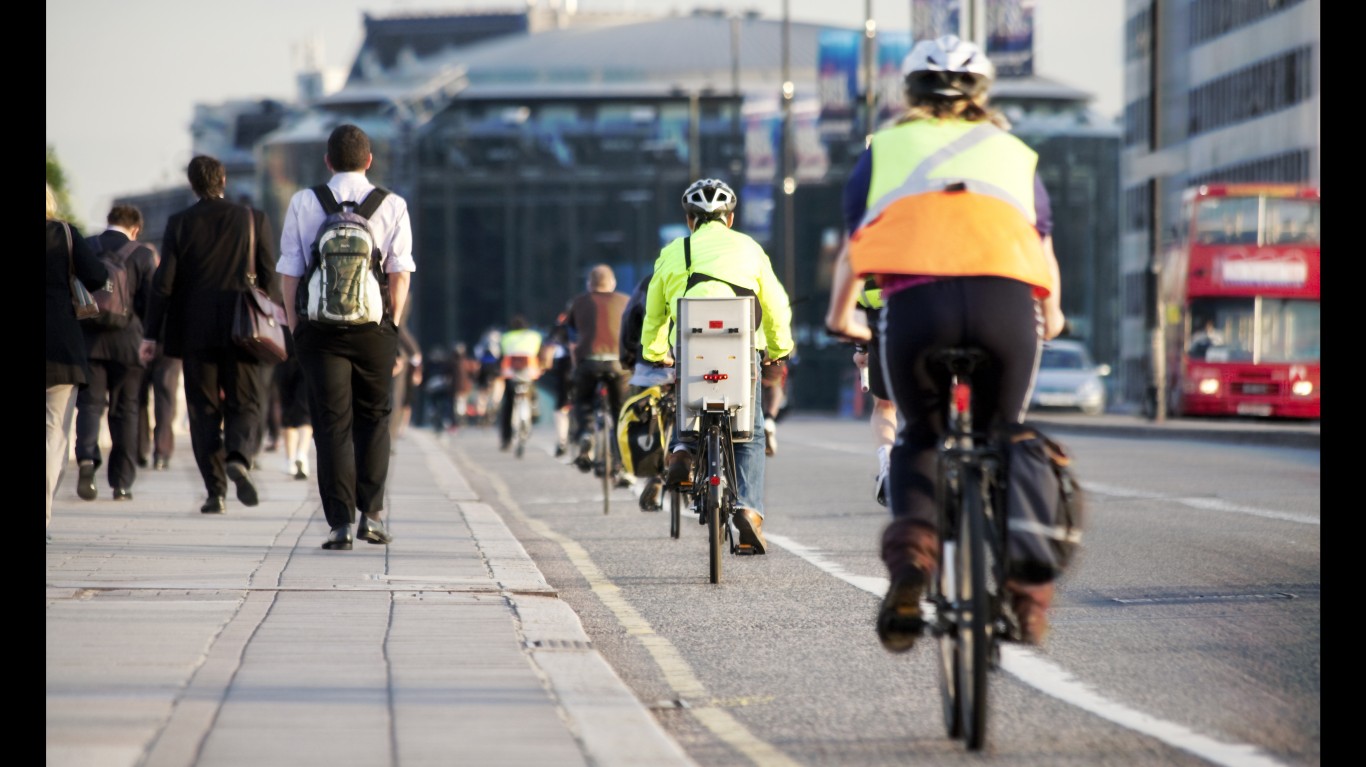
43. London, UK
> Population density: 13,210 per square mile
> Population: 8,278,000
> Square miles: 627 miles
More than 300 languages are spoken by students in London, the capital city of England, where foreign-born migrants make up a sizable chunk of the population. However, the U.K. also has a high rate of internal migration, with London a revolving door of people arriving to take advantage of business opportunities, jobs, high salaries and the seductive lure of the big city. Others leave the metropolis to raise families or in search of a lower cost of living.
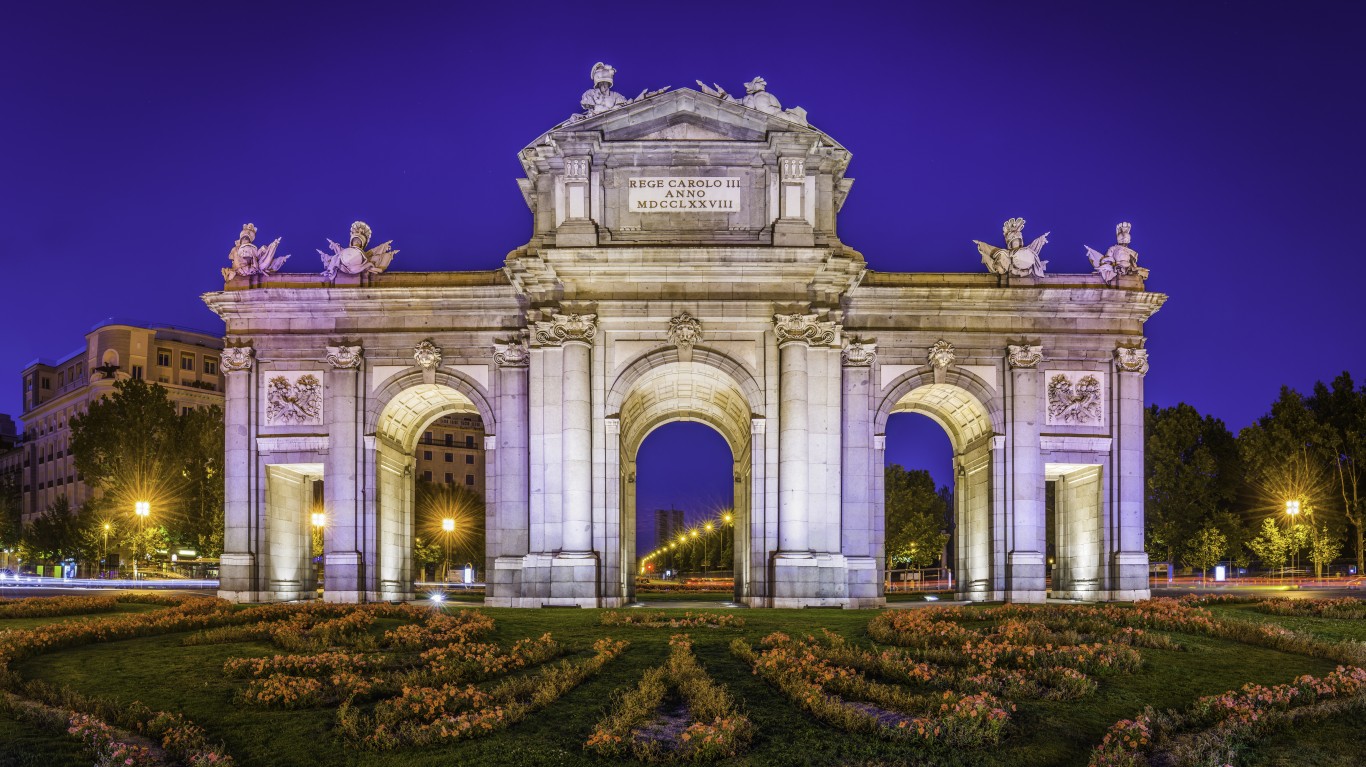
42. Madrid, Spain
> Population density: 13,430 per square mile
> Population: 4,900,000
> Square miles: 365 miles
The largest city in Spain as well as its capital, Madrid is among the most densely populated metropolitan areas in Europe. Besides being known for its sports teams, cultural institutions, history and architecture, the city is among Europe’s biggest financial centers, a hub of international business and commerce, as well as Spain’s main manufacturing center. Most of the nation’s wealthiest neighborhoods are located in the capital city.
[in-text-ad-2]

41. Ankara, Turkey
> Population density: 13,772 per square mile
> Population: 3,100,000
> Square miles: 225 miles
More than half of Turkey’s borders are coastal, but the landlocked Ankara is its capital. It ranks second to Istanbul in size and industrial importance. Government is the biggest business, followed by manufacturing of everything from food products to construction materials and tractors. Ankara recently opened the largest hospital in Europe, with more than 3,600 beds, 12,000 employees, and eight divisions specializing in various types of medicine.
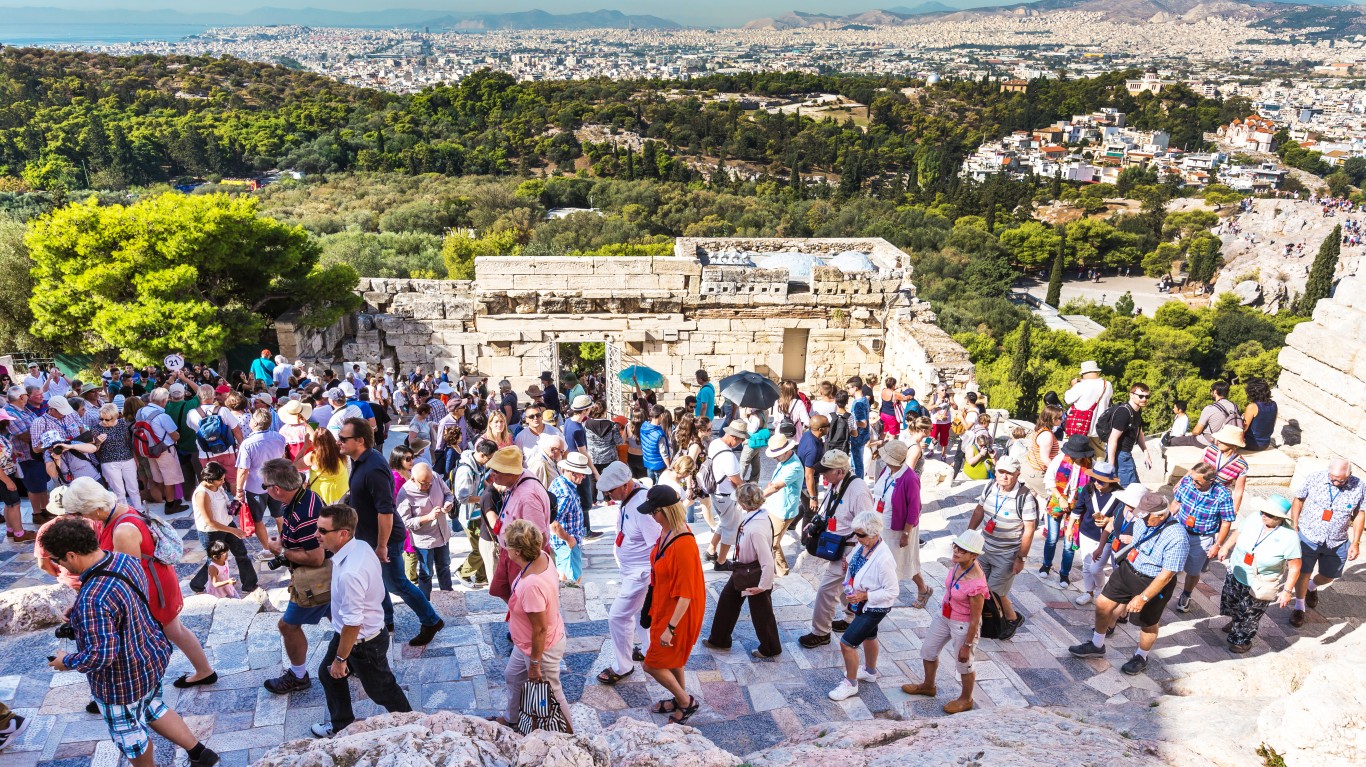
40. Athens, Greece
> Population density: 13,953 per square mile
> Population: 3,685,000
> Square miles: 264 miles
With a written history going back more than three millennia, Athens is one of the oldest cities in the world. The Greek capital continues to be the heart of the country’s political, cultural, financial and economic life. The ancient city was recently rated highly on a list of cheap European vacations, cited for its antiquities, museums and charming neighborhoods for dining and shopping.
[in-text-ad]
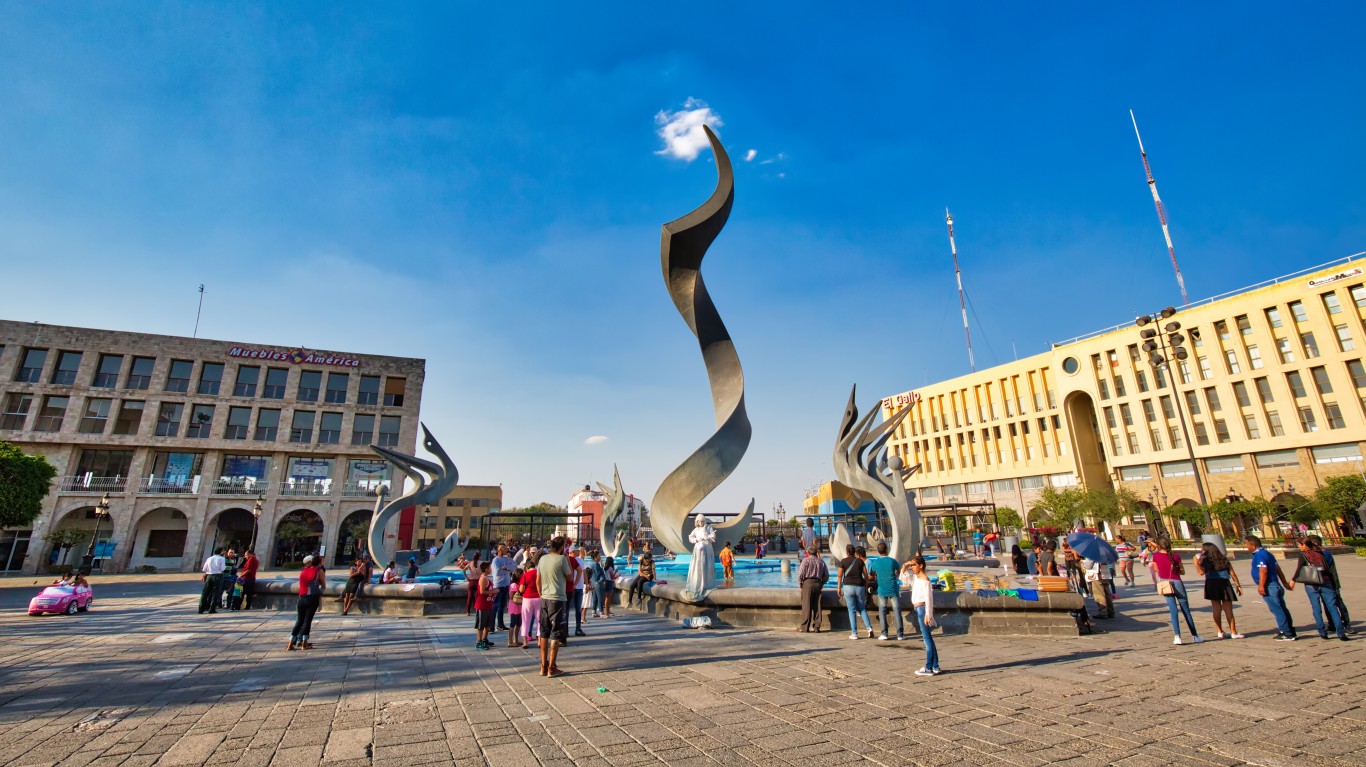
39. Guadalajara, Mexico
> Population density: 15,210 per square mile
> Population: 3,500,000
> Square miles: 230 miles
One of three Mexican cities among the top 50 most densely populated areas in the world, Guadalajara is the capital and the largest urban area in the state of Jalisco. It has gained a reputation as the Silicon Valley of Mexico, with a sizable talent pool of coders, engineers and programmers, along with startups and venture capital. Besides that, Guadalajara is known for its tequila and mariachi bands.
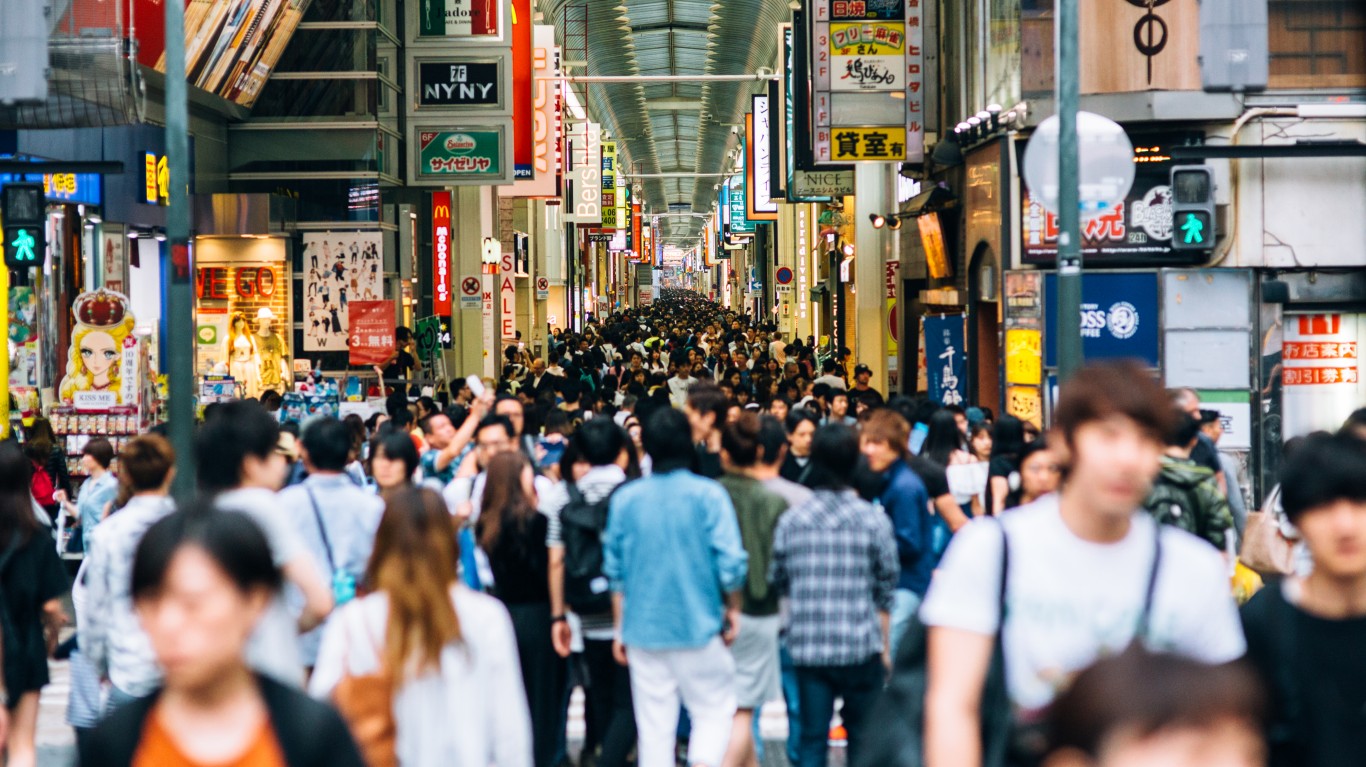
38. Osaka/Kobe/Kyoto, Japan
> Population density: 16,592 per square mile
> Population: 16,425,000
> Square miles: 990 miles
Osaka, Kobe and Kyoto comprise the most densely populated region in Japan; each is the capital of its prefecture, and the combined area is known as the Kansai region. The major industries include manufacturing, distribution, finance and high tech. Attractions such as temples, castles, shopping, and dining abound in the region.

37. Bangkok, Thailand
> Population density: 16,668 per square mile
> Population: 6,500,000
> Square miles: 390 miles
Thailand’s capital as well as its most densely populated city, Bangkok is the country’s center of government, finance and industry. While the majority of the residents are of Thai ethnicity, the city has a variety of districts with Chinese, Indian, Japanese and Arab populations. While numerous sites give Bangkok high marks for quality of life, citing affordable cost of living, vibrant culture, good education and job opportunities. On the down side, its air pollution is among the worst on Earth.
[in-text-ad-2]

36. Monterrey, Mexico
> Population density: 17,303 per square mile
> Population: 3,200,000
> Square miles: 185 miles
Monterrey is the capital of the Mexican state of Nuevo León, which has the nation’s strongest economy. Construction and manufacturing surged in the state in 2018, and foreign direct investment (FDI) increased 127% over the previous year. The local unemployment rate hovers around 3.5%. But Monterrey isn’t all work and no play — the city currently features a lively nightlife, plus outdoor activities and cultural institutions, and the World Cup is on the schedule for 2024.

35. Khartoum, Sudan
> Population density: 17,770 per square mile
> Population: 4,000,000
> Square miles: 225 miles
Khartoum is the capital of Sudan. Political unrest is rampant in this northeastern African nation. Last spring, the military ousted autocratic leader Omar al-Bashir, and since then, Khartoum has been the site of often-violent demonstrations, with at least 11 people killed during June 30 protests this summer. American travelers are urged to stay away from the area because of terrorism and civil unrest.
[in-text-ad]

34. Rio de Janeiro, Brazil
> Population density: 17,704 per square mile
> Population: 10,800,000
> Square miles: 610 miles
Though capital cities are often a country’s most densely populated area, that’s not the case in Brazil. Rio de Janeiro regularly attracts attention for special events such as the recent Copa America tournament and the annual carnival celebration, believed to be the biggest in the world. Though tourism plays an important role in the city’s economy, oil, agriculture, banking, fishing and finance are all major industries as well.
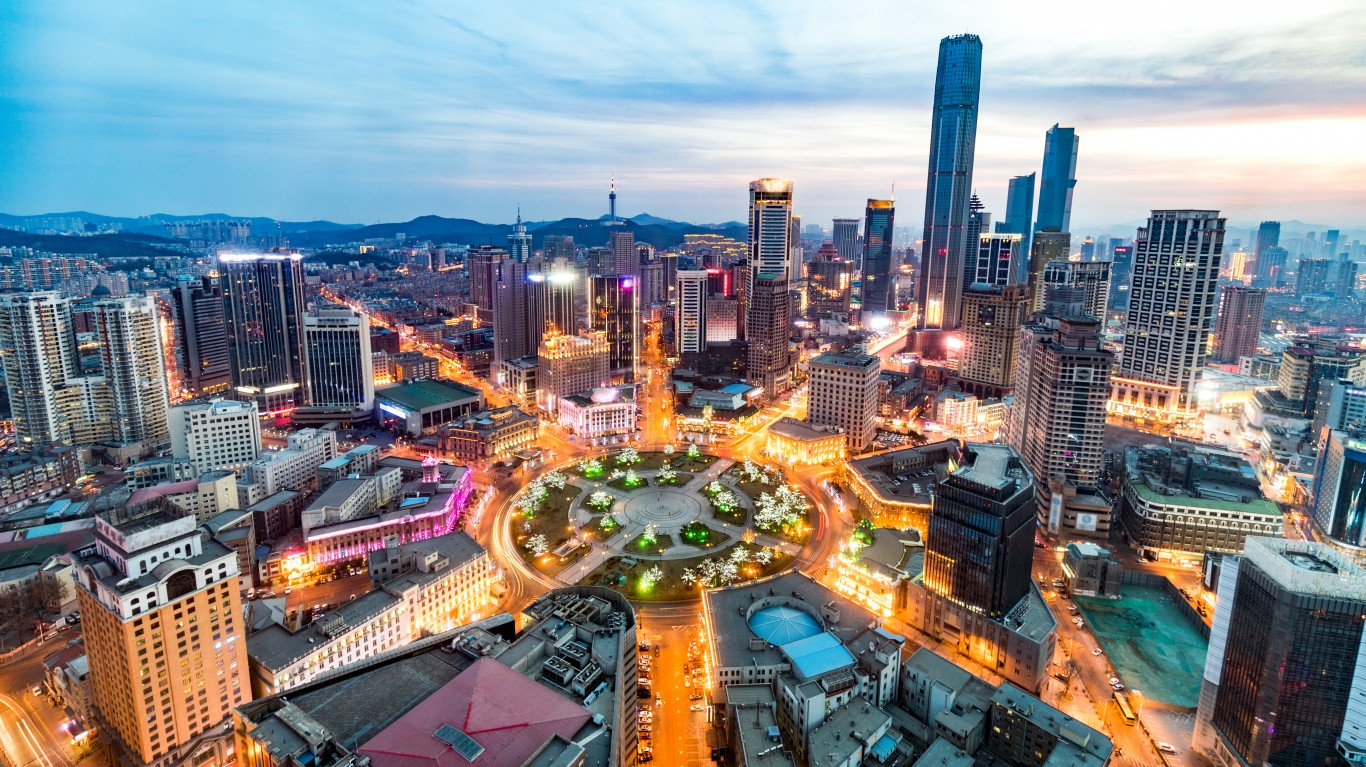
33. Dalian, China
> Population density: 18,310 per square mile
> Population: 2,750,000
> Square miles: 150 miles
All eyes were on Dalian at the start of July, as the northeastern China city hosted the 2019 World Economic Forum’s Annual Meeting of the New Champions, or Summer Davos Forum. This is the seventh time the forum has been held in Dalian since 2007. The forum, which typically draws about 2,000 participants from around the world, has elevated the city’s profile internationally, and spurred infrastructure development, including new roads and building reconstruction. Dalian aims to increase its importance as an international trading center.
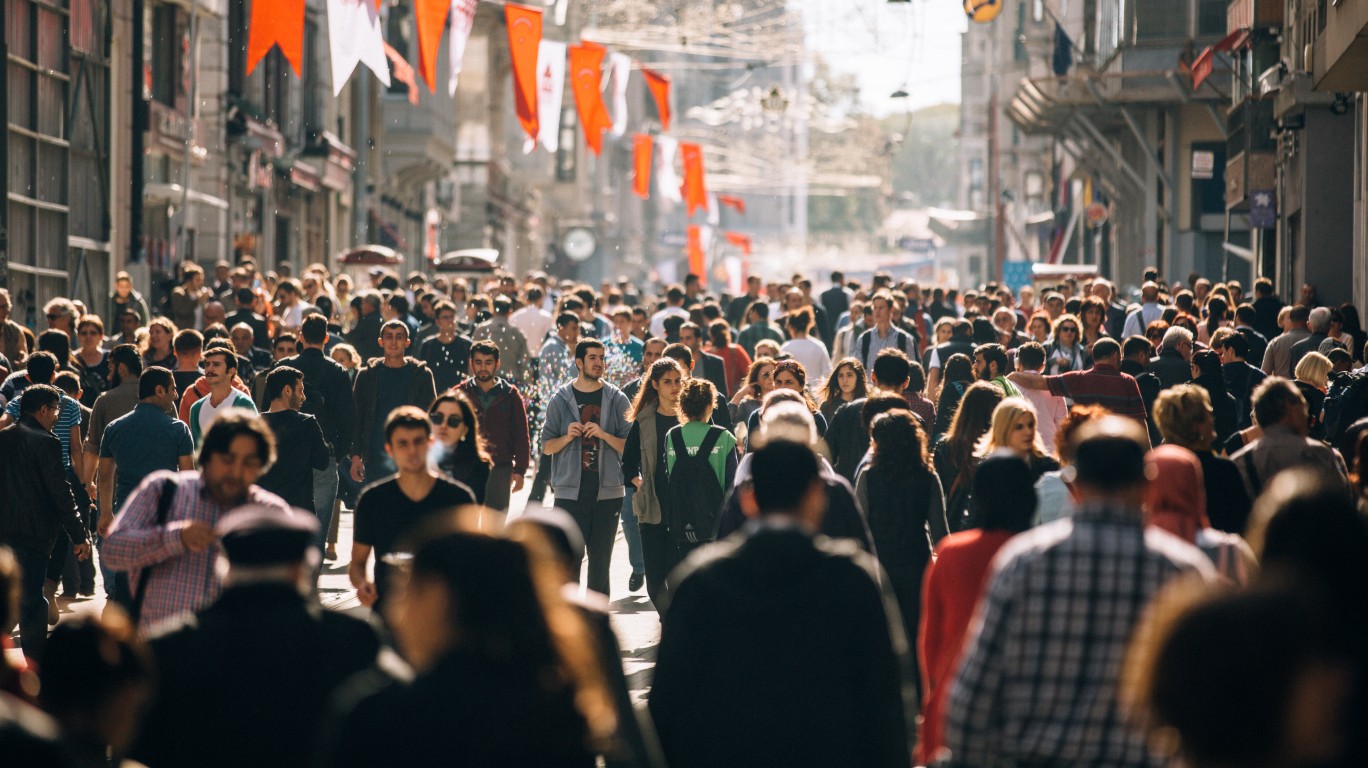
32. Istanbul, Turkey
> Population density: 19,991 per square mile
> Population: 9,000,000
> Square miles: 450 miles
Not only is Istanbul the most densely populated city in Turkey, it is also the largest transcontinental city in the world, with its well-packed footprint landing in both Europe and Asia. The city, which is known for having some of the worst traffic in the world, is looking to the sky: It’s currently building the world’s largest airport. In recent years, Istanbul has become a destination for hundreds of thousands of Syrians, with Turkey ranking as the country taking in the most refugees worldwide.
[in-text-ad-2]

31. Recife, Brazil
> Population density: 20,837 per square mile
> Population: 3,025,000
> Square miles: 145 miles
With two ports, a thriving IT industry, agriculture and manufacturing, Recife is the major business and economic powerhouse of northeastern Brazil. The capital of the state of Pernambuco, the city is the second largest medical center in the country. With hundreds of hospitals and clinics, thousands of beds, and the latest medical technology, it serves patients across a large area. Unfortunately, Recife also has a high crime rate, including homicides, earning it a place on the list of most dangerous cities in the world as well.
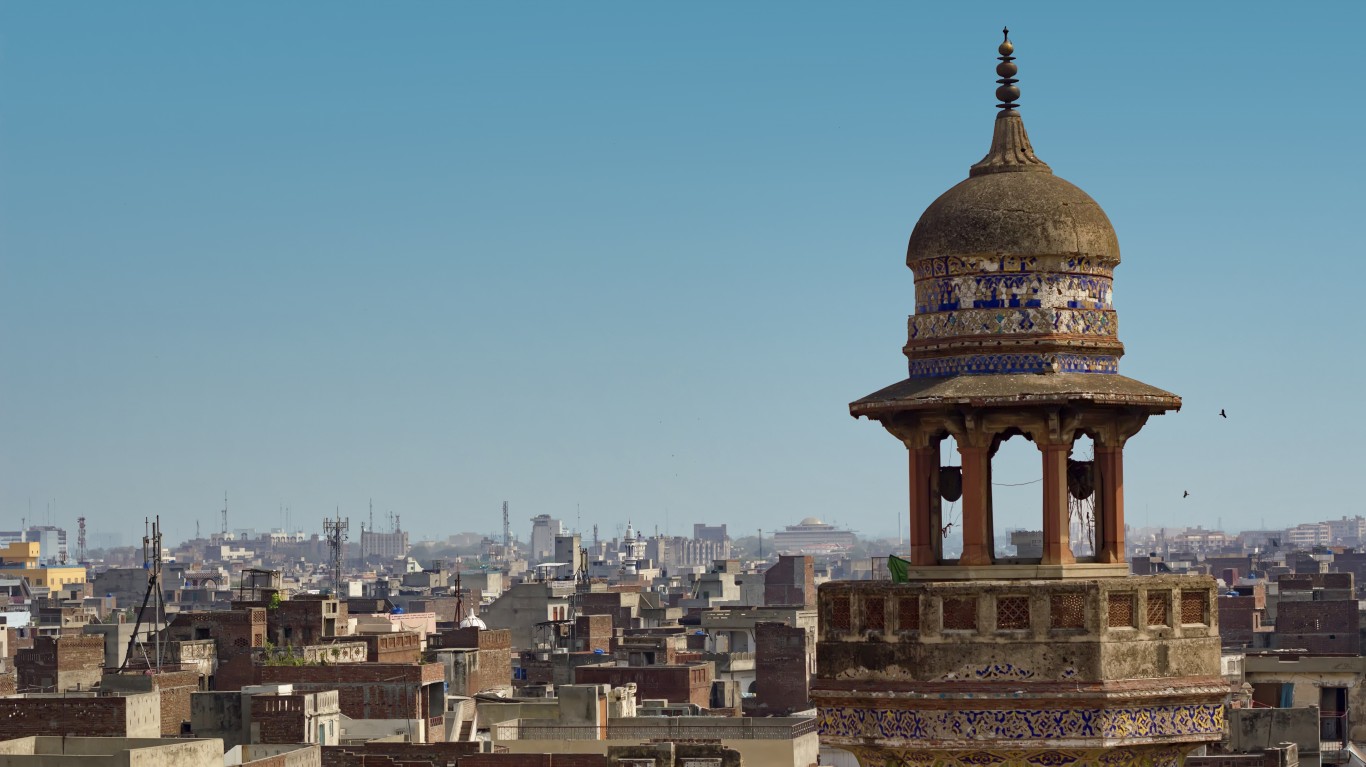
30. Lahore, Pakistan
> Population density: 21,236 per square mile
> Population: 5,100,000
> Square miles: 240 miles
The capital of the Punjab province, the second largest province by area, Lahore is Pakistan’s second most populous city, with less than half the population density of the nation’s capital city, Karachi. Punjabi, Urdu and English are the most commonly spoken languages in Lahore. The metropolis is the nation’s engineering hub, producing cars, heavy machinery, steel, chemicals and more. Industry, traffic, crop burning and solid waste disposal all contribute to making this regional capital one of the world’s most polluted cities.
[in-text-ad]
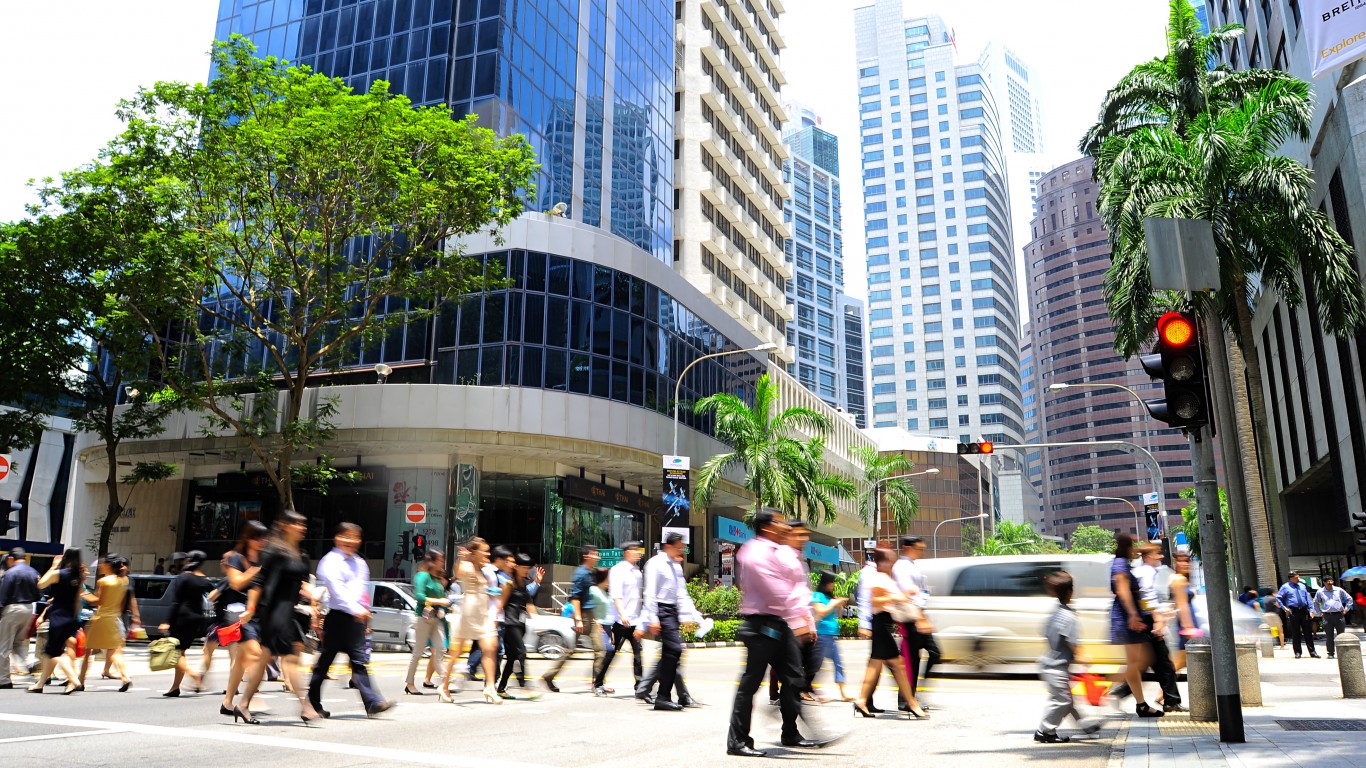
29. Singapore
> Population density: 21,628 per square mile
> Population: 4,000,000
> Square miles: 185 miles
Often referred to as an economic tiger, Singapore, an island city-state, boasts a high gross domestic product per capita, low unemployment, and thriving electronics and pharmaceutical industries. The city often has superlatives linked with its name: It’s among the most expensive city in the world (it’s a three-way tie with Paris and Hong Kong), the world’s most competitive economy, and — perhaps surprisingly, in such a high-rise environment — the city with the most trees, to name just a few of its attributes.
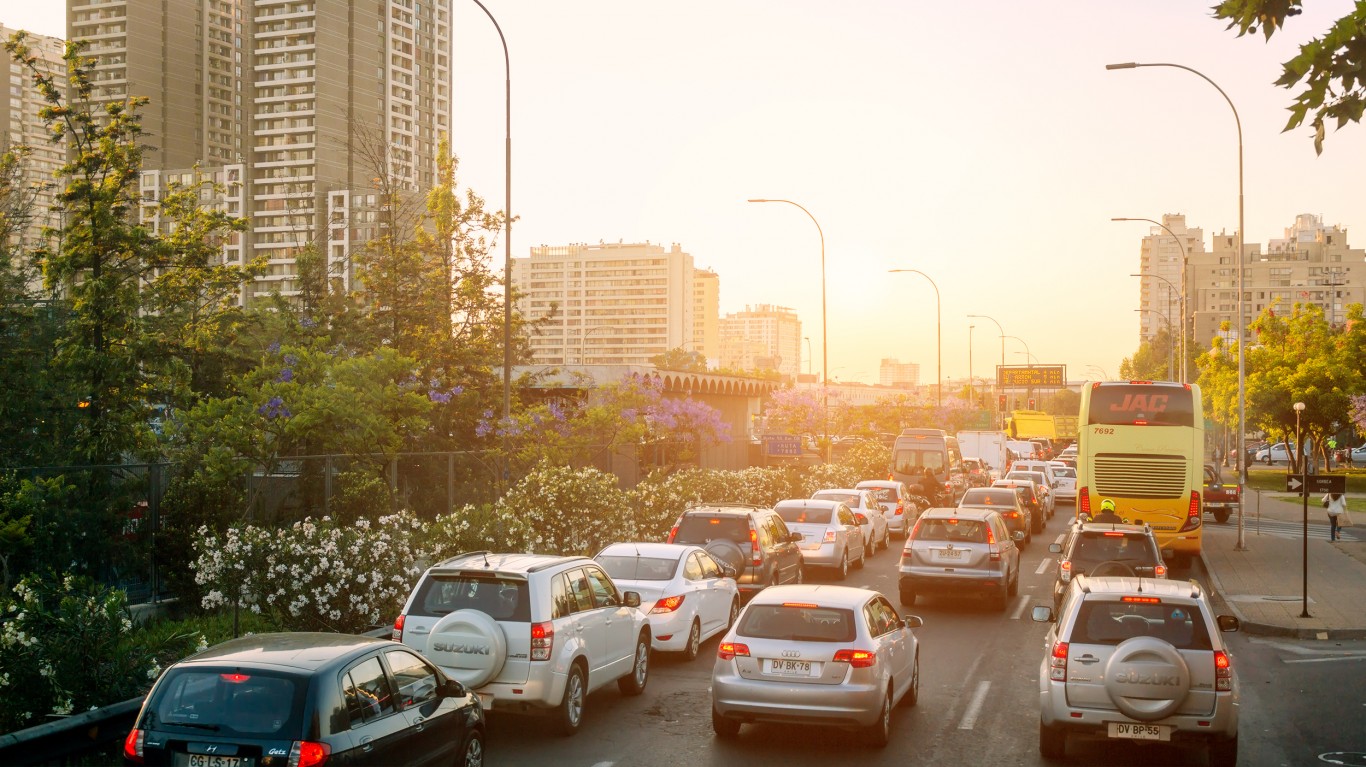
28. Santiago, Chile
> Population density: 21,683 per square mile
> Population: 5,425,000
> Square miles: 250 miles
On a clear day, you have a good view of the Andes Mountains from Santiago, Chile’s capital city. The fourth most densely populated city in South America is also home to the continent’s tallest building, the Gran Torre Santiago, standing almost 1,000 feet high. The city has the country’s greatest concentration of industry, which includes clothing, shoe and textile manufacturing; banking and a stock exchange; and mining and metallurgy.
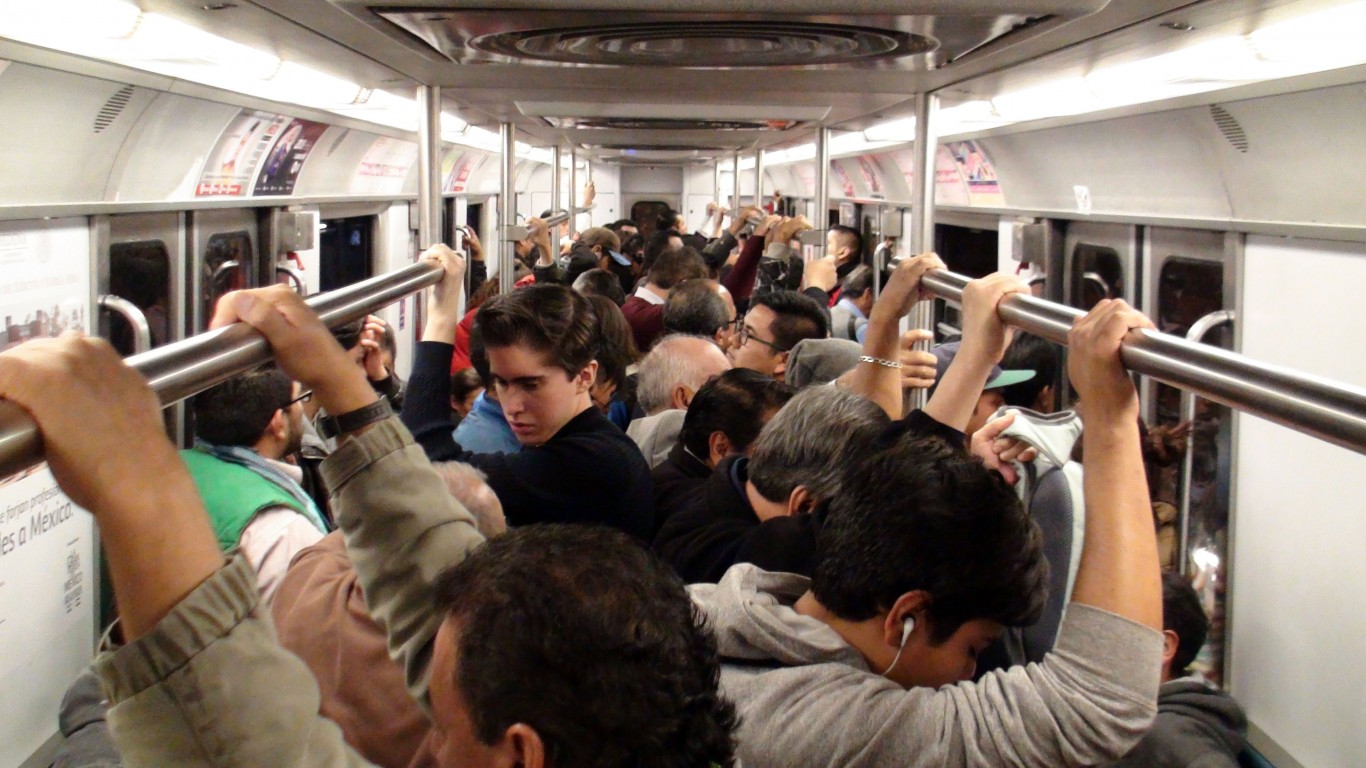
27. Mexico City, Mexico
> Population density: 21,750 per square mile
> Population: 17,400,000
> Square miles: 800 miles
Mexico City, situated more 7,300 feet above sea level, is North America’s highest capital city, as well as its most densely populated metropolitan area. It is also the world’s largest Spanish-speaking city, and one of the largest financial centers on the continent. Mexico City has a large immigrant and expatriate population from the around the globe, including the U.S., Canada, Europe, the Caribbean and elsewhere. Warm weather, good food and a lower cost of living are among the attractions.
[in-text-ad-2]

26. St Petersburg, Russia
> Population density: 22,069 per square mile
> Population: 5,300,000
> Square miles: 240 miles
Located just below the Arctic Circle in the far northwest, St. Petersburg served as the capital of the Russian Empire for more than two centuries, until Moscow took over the honors in 1918. St. Petersburg remains a huge and important city 100 years post the Bolshevik revolution, and its historical district was named a UNESCO world heritage site in 1990. In addition to its major Baltic Sea port, the city is known as a Russian cultural center teeming with theaters, concert halls, palaces and museums, and architectural wonders. The Museum of Soviet Arcade Machines is a unique venue, featuring vending machines and games that were the Soviet equivalent of Pac-Man, with an ideological component.
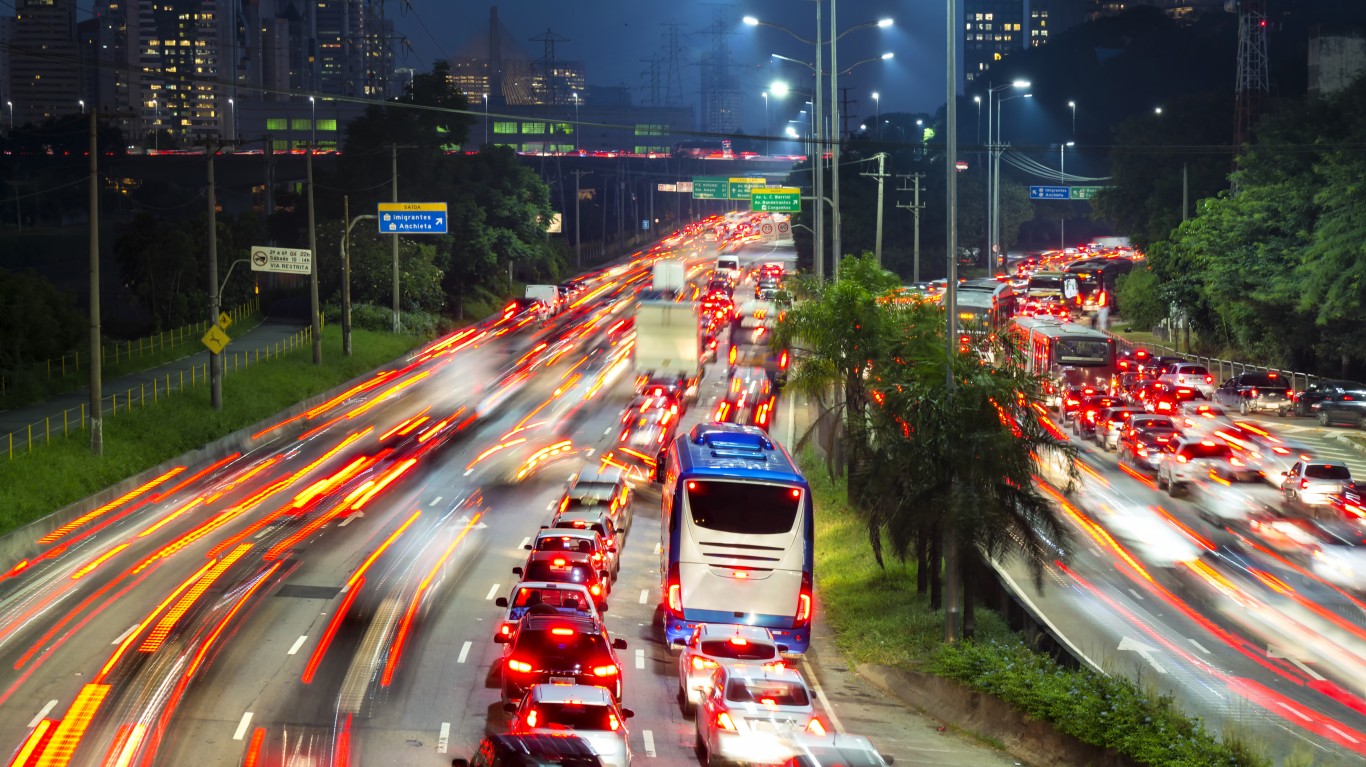
25. São Paulo, Brazil
> Population density: 23,294 per square mile
> Population: 17,700,000
> Square miles: 760 miles
São Paulo is Brazil’s most densely populated area, one of the most crowded metro areas in the Southern Hemisphere, and the world’s largest Portuguese-speaking city. The capital of the state of the same name, São Paulo is the financial capital of Brazil. It is also a major export center, dealing in products such as soybean, coffee, raw sugar and corn.
[in-text-ad]
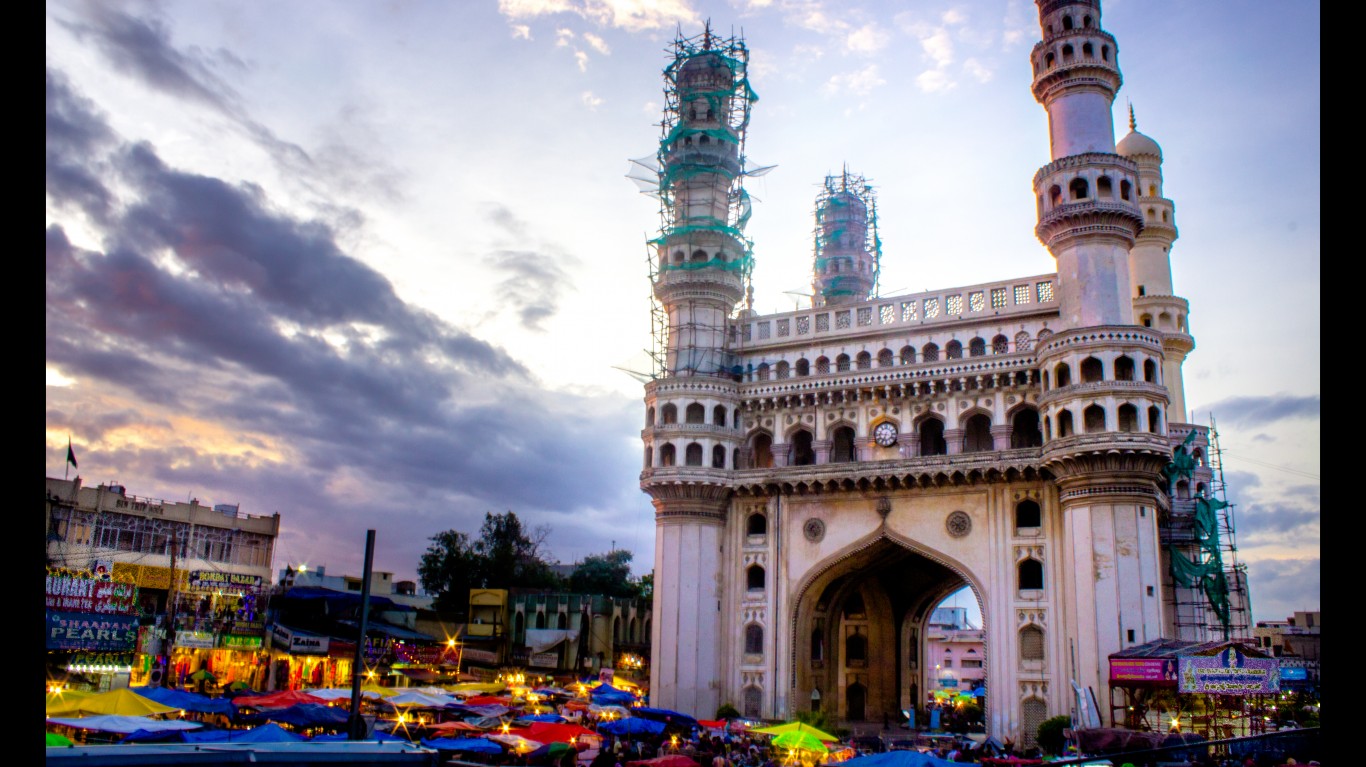
24. Hyderabad, India
> Population density: 23,545 per square mile
> Population: 5,300,000
> Square miles: 225 miles
In a 2018 report, Hyderabad was credited with having the highest gross domestic product growth among 20 cities in emerging Asia-Pacific nations. The city, which is the capital of the state of Telangana, was rated second among nine Indian cities for employment growth rate over two years. For the fourth straight year, Hyderabad was named India’s top city for standard of living.

23. Shenyang, China
> Population density: 24,013 per square mile
> Population: 4,200,000
> Square miles: 175 miles
This northeastern Chinese industrial city is located a little more than 300 miles from the North Korea border. The capital of Liaoning Province, Shenyang’s main products include cars and auto parts, construction materials, chemicals, steel and agricultural products. Unlike Northeast China’s other provincial capital cities, Shenyang’s population has grown in recent years, with the increase attributed to job seekers, increased college enrollment and more families having second children.

22. Baghdad, Iraq
> Population density: 23,901 per square mile
> Population: 5,500,000
> Square miles: 230 miles
Following the defeat of the Islamic State last year, Baghdad residents reported that life was starting to feel somewhat safe and normal. People who had fled during more than a decade of war and upheaval began returning to their hometown, the capital of Iraq. The economy in Iraq had been picking up in recent months.
[in-text-ad-2]
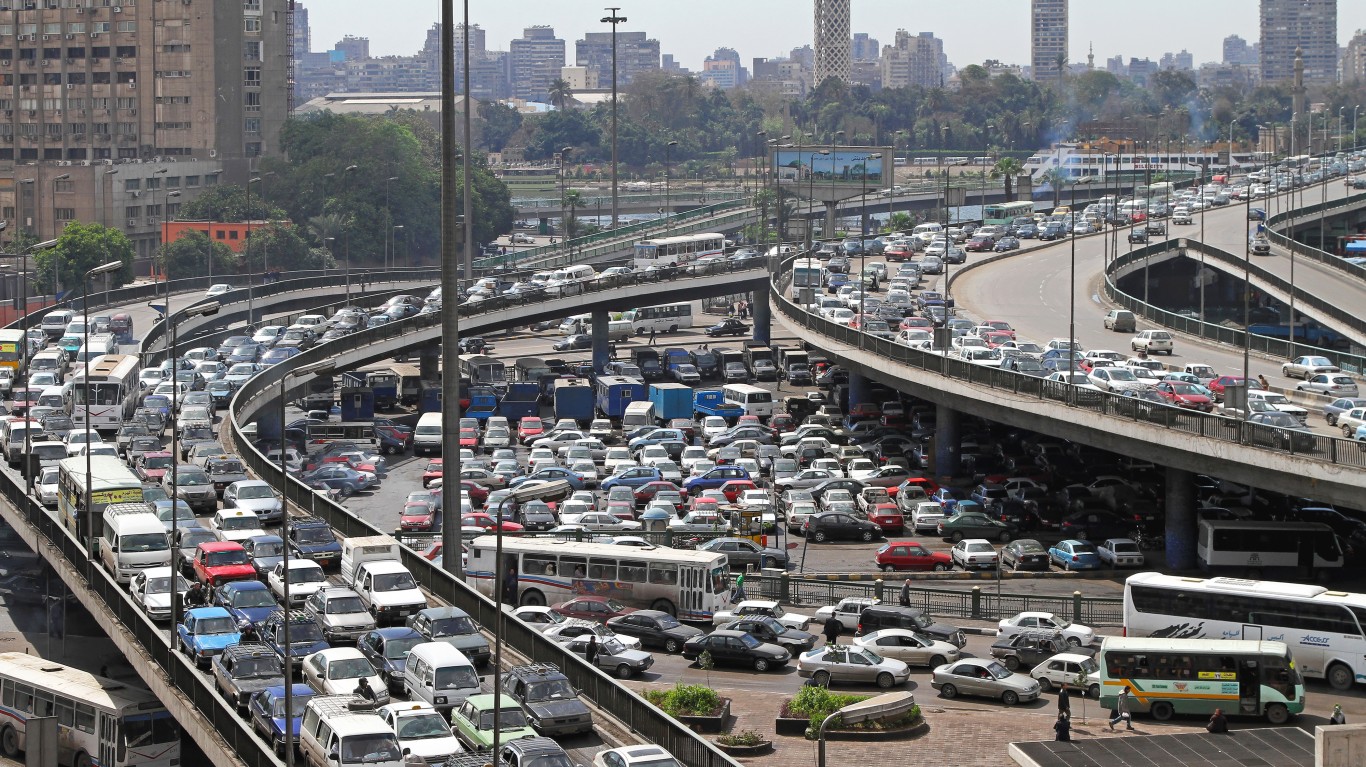
21. Cairo, Egypt
> Population density: 24,400 per square mile
> Population: 12,200,000
> Square miles: 500 miles
Cairo is among the most densely populated cities in Africa, with its ongoing growth attributed to the disparity between the annual birth rate (30 births per 1,000 people) and death rate (7 deaths per 1,000 people). Egypt’s capital city has such a perennial housing shortage that for decades residents have occupied every viable bit of space, including among the above-ground tombs in the el-Arafa necropolis, also known as the City of the Dead.
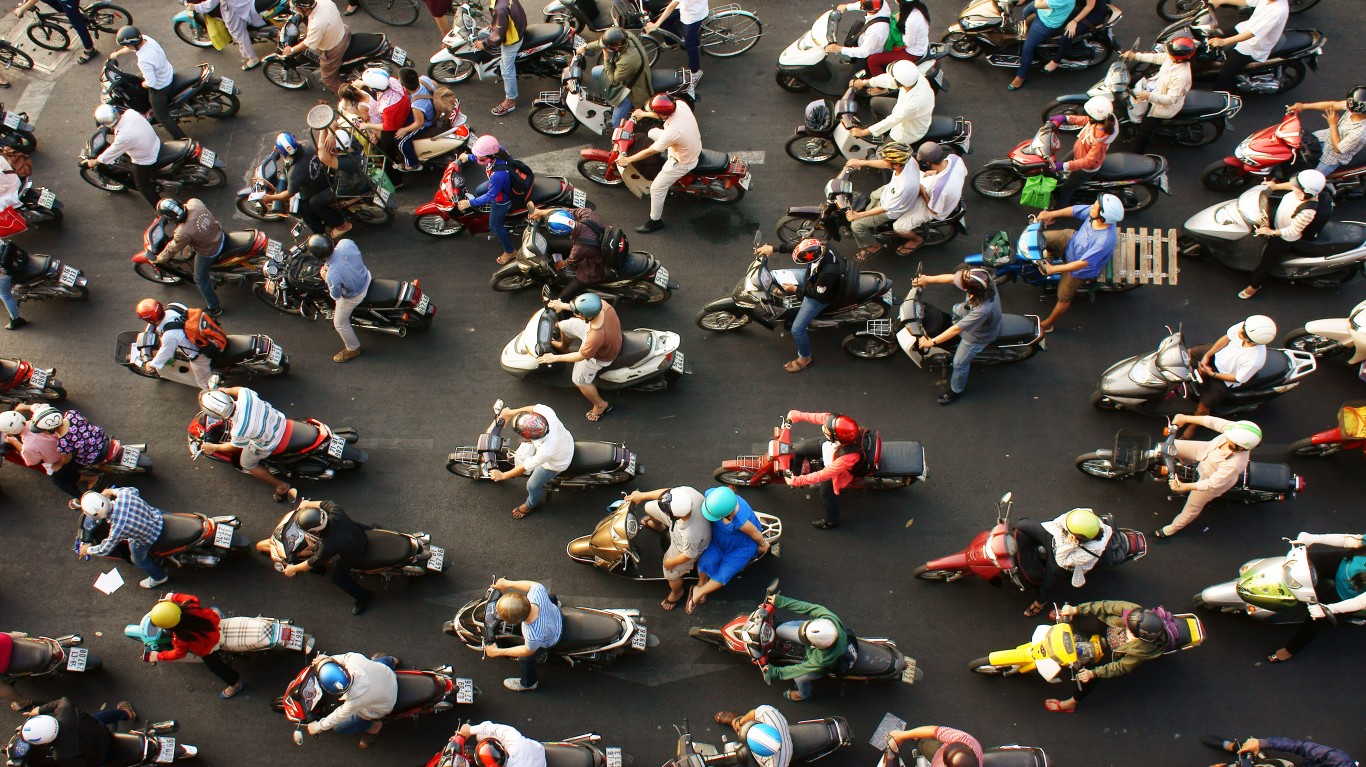
20. Ho Chi Minh City, Vietnam
> Population density: 24,500 per square mile
> Population: 4,900,000
> Square miles: 200 miles
Ho Chi Minh City’s population is more than double the population of Hanoi, Vietnam’s capital and the next largest city. Migrants are attracted to the city for job opportunities in manufacturing, business and tourism, and by the per capita gross domestic product, which is twice as high as the national average in 2016. The country is investing in infrastructure improvements, such as Ho Chi Minh’s metro rapid transit network, to help Vietnam preserve its status as one of the world’s fastest growing tourist destinations.
[in-text-ad]
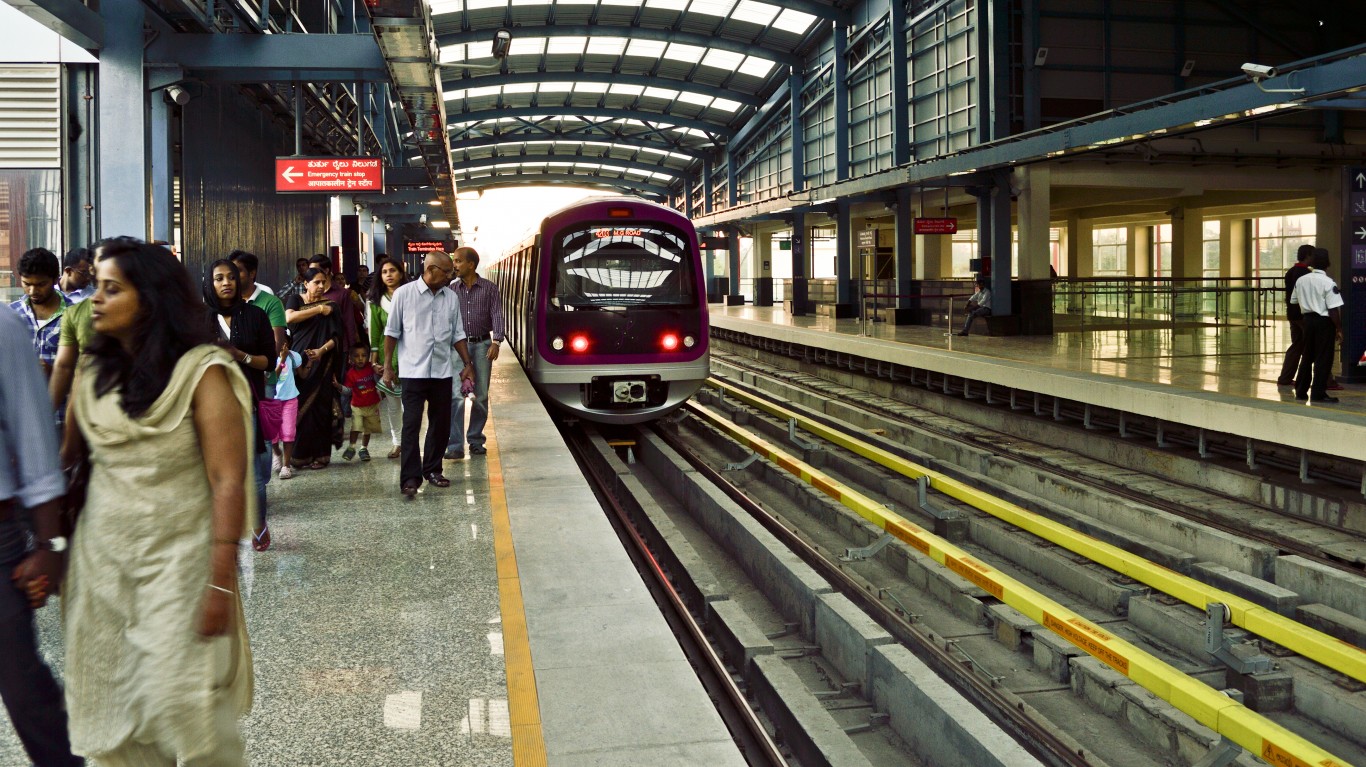
19. Bangalore, India
> Population density: 26,191 per square mile
> Population: 5,400,000
> Square miles: 206 miles
Bangalore is one of the world’s least expensive cities. Nevertheless, it’s standard of living was rated among the best in India in a recent report, which may explain why much of the population growth in Bangalore is due to migration from other Indian states. The capital of the state of Karnataka, Bangalore is home to many tech companies, earning it the nickname of the Silicon Valley of India.
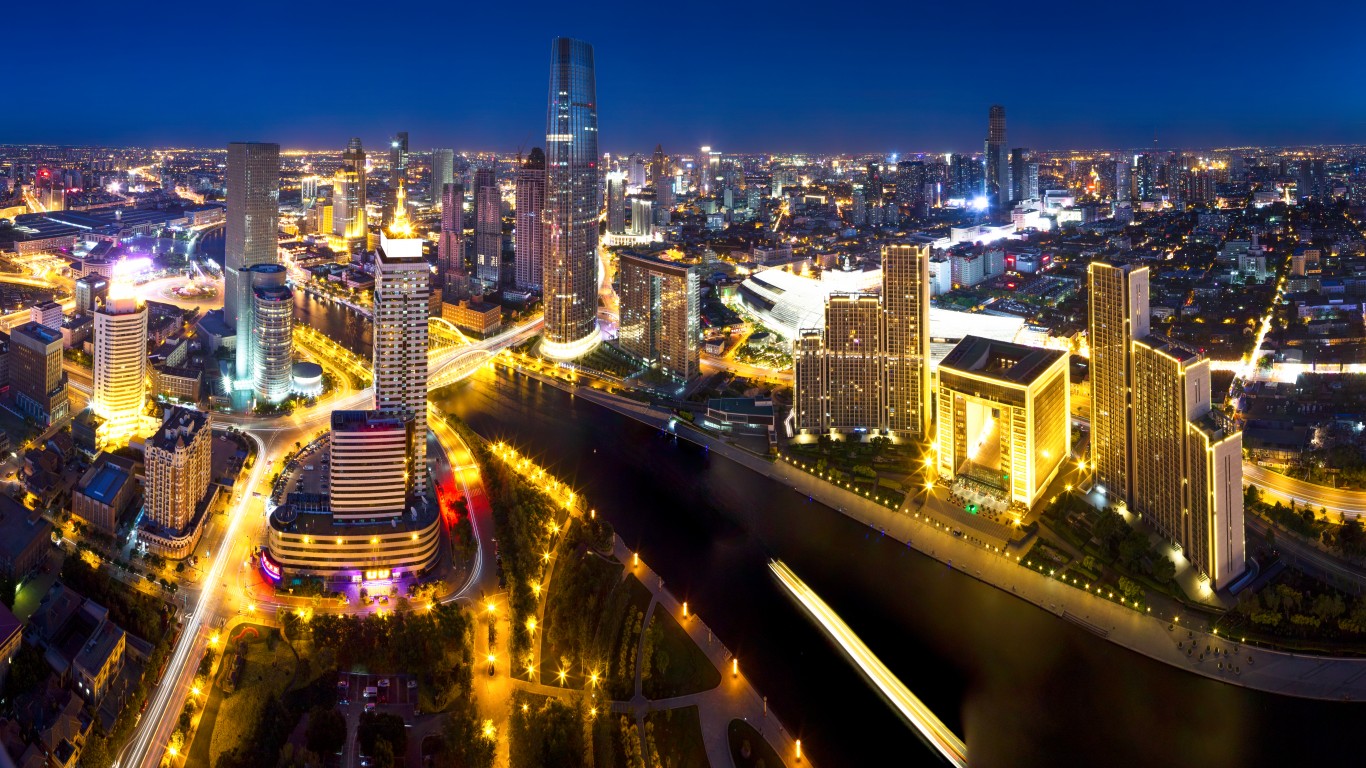
18. Tianjin, China
> Population density: 27,158 per square mile
> Population: 4,750,000
> Square miles: 175 miles
China’s largest coastal city, Tianjin has the biggest port in the northern part of the country. Besides being a major transport and shipping hub, the city is also a manufacturing center, producing cars, textiles, metalwork and chemicals. Tianjin is China’s fourth most densely populated city, with growth expected to continue over the next decade.

17. Jakarta, Indonesia
> Population density: 27,138 per square mile
> Population: 14,250,000
> Square miles: 525 miles
Employment opportunities and a high standard of living are among the factors causing people from across Indonesia to migrate to the capital city of Jakarta. About half of the population is thought to have actually been born in the city. The growth, which is predicted to continue, has brought problems, including the worst air pollution in Southeast Asia. Auto emissions and coal-fired power plants are among the main sources of the hazardous air quality.
[in-text-ad-2]

16. Tehran, Iran
> Population density: 27,372 per square mile
> Population: 7,250,000
> Square miles: 265 miles
Migrants are behind the population growth in Tehran. Most of the newcomers to the capital of Iran come from other cities within the country. However, reverse migration could be on the upswing, with residents becoming concerned about environmental problems and fewer economic opportunities. Though Tehran is an old and interesting city, Iran ranks high on the list of countries the U.S. government doesn’t want you to visit, citing a high risk of kidnapping, arrest and detention.
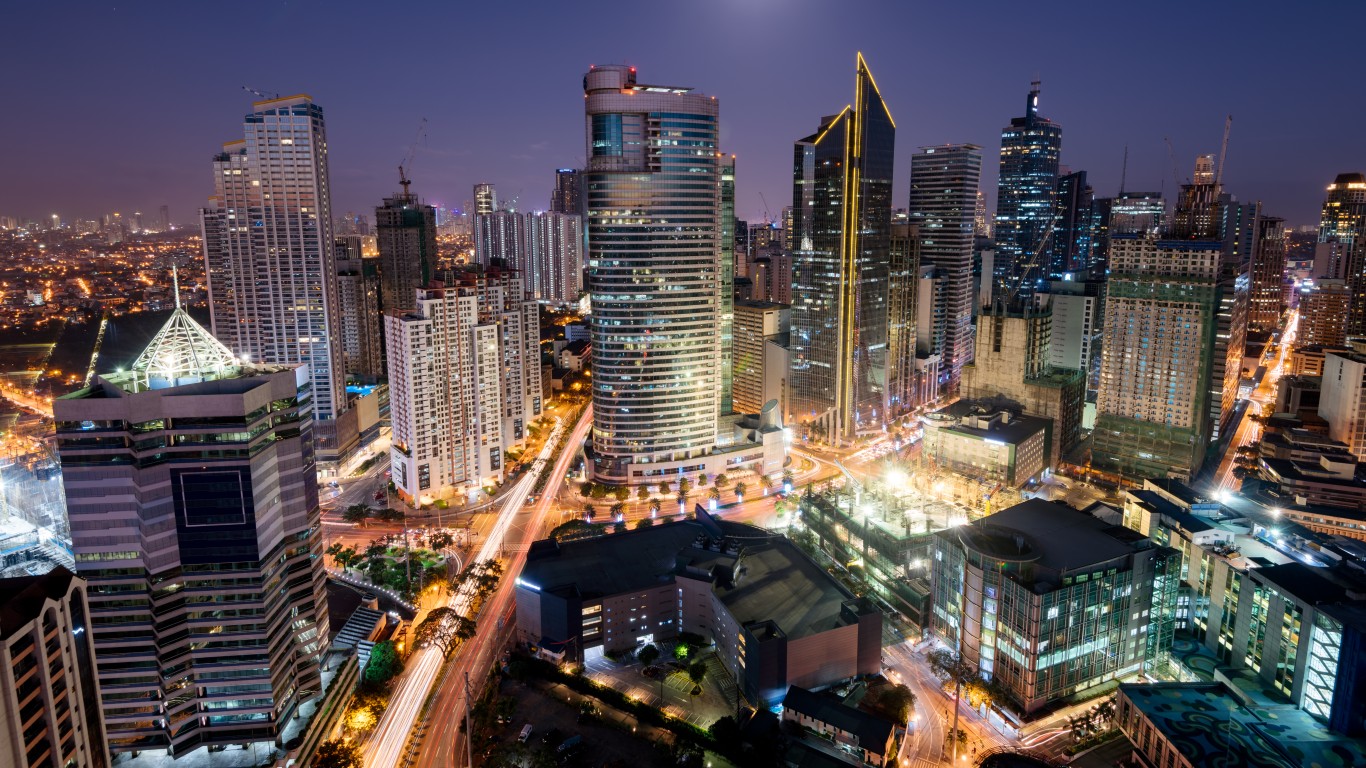
15. Manila, Philippines
> Population density: 27,307 per square mile
> Population: 14,750,000
> Square miles: 540 miles
Based on employment growth and gross domestic production per capita growth between 2014 and 2016, Manila has a solid place on the list of top-performing metro areas, according to a study published in 2018. The densely populated city had employment growth of 5.7%, and GDP per capita of 5.5%, landing it among the 10 top performers on Earth. While the solid financial outlook may contribute to growth, Manila could become a destination for dedicated shoppers: The Philippine capital is the site of the biggest Ikea store in the world, which is set to open in 2020.
[in-text-ad]
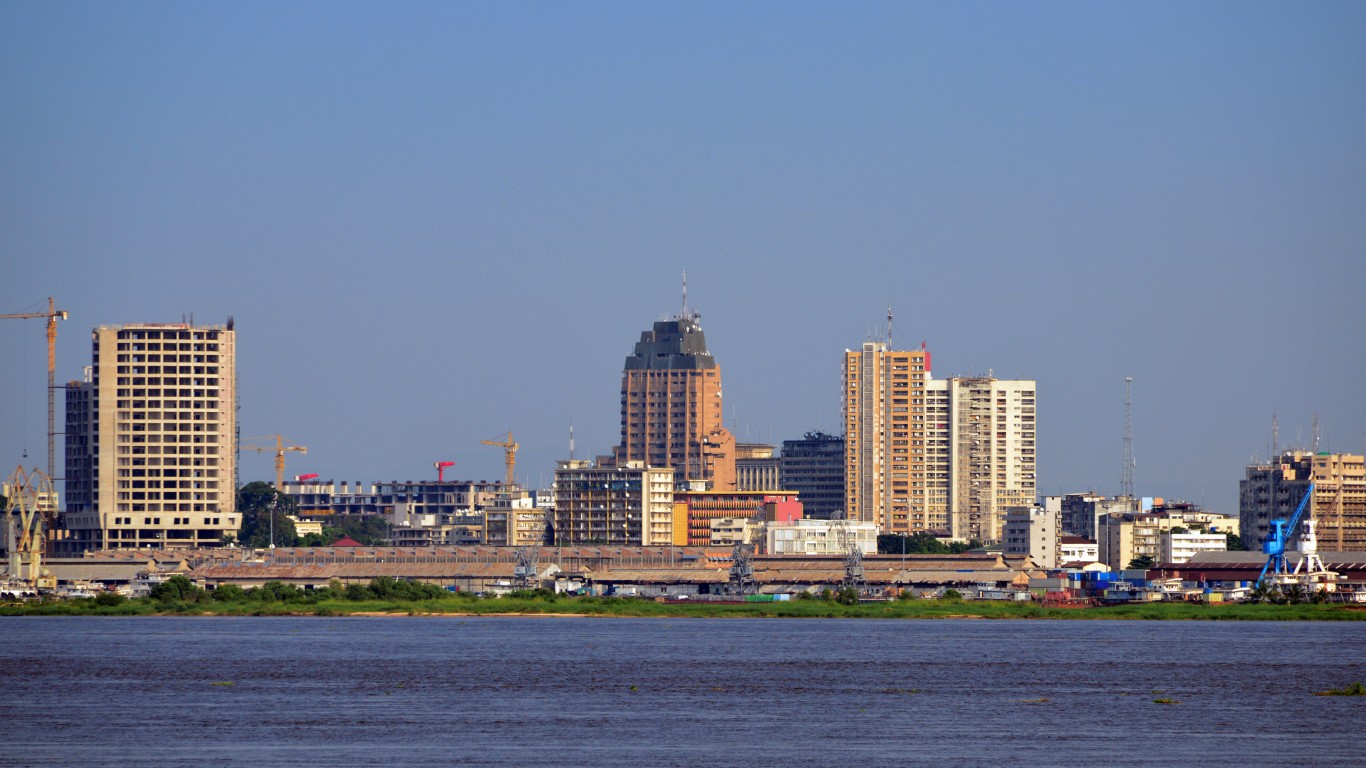
14. Kinshasa, DRC
> Population density: 27,612 per square mile
> Population: 5,000,000
> Square miles: 181 miles
Migration from rural areas, high fertility rates, and widening of the city’s boundaries have contributed to the burgeoning population in Kinshasa, the capital of the Democratic Republic of the Congo. With a life expectancy of just over 50 years, millions of people facing food insecurity, and 85% of the population believing their government is corrupt, the DRC is considered one of the world’s most miserable places to life.

13. New Delhi, India
> Population density: 28,600 per square mile
> Population: 14,300,000
> Square miles: 500 miles
There’s always a trade-off: New Delhi is one of the least expensive cities in the world, but it also has some of the worst air quality. Improved infrastructure, education and standard of living have attracted people from all over the country to India’s capital. Technology, banking, transportation and government are the biggest employers in this densely populated metro area.
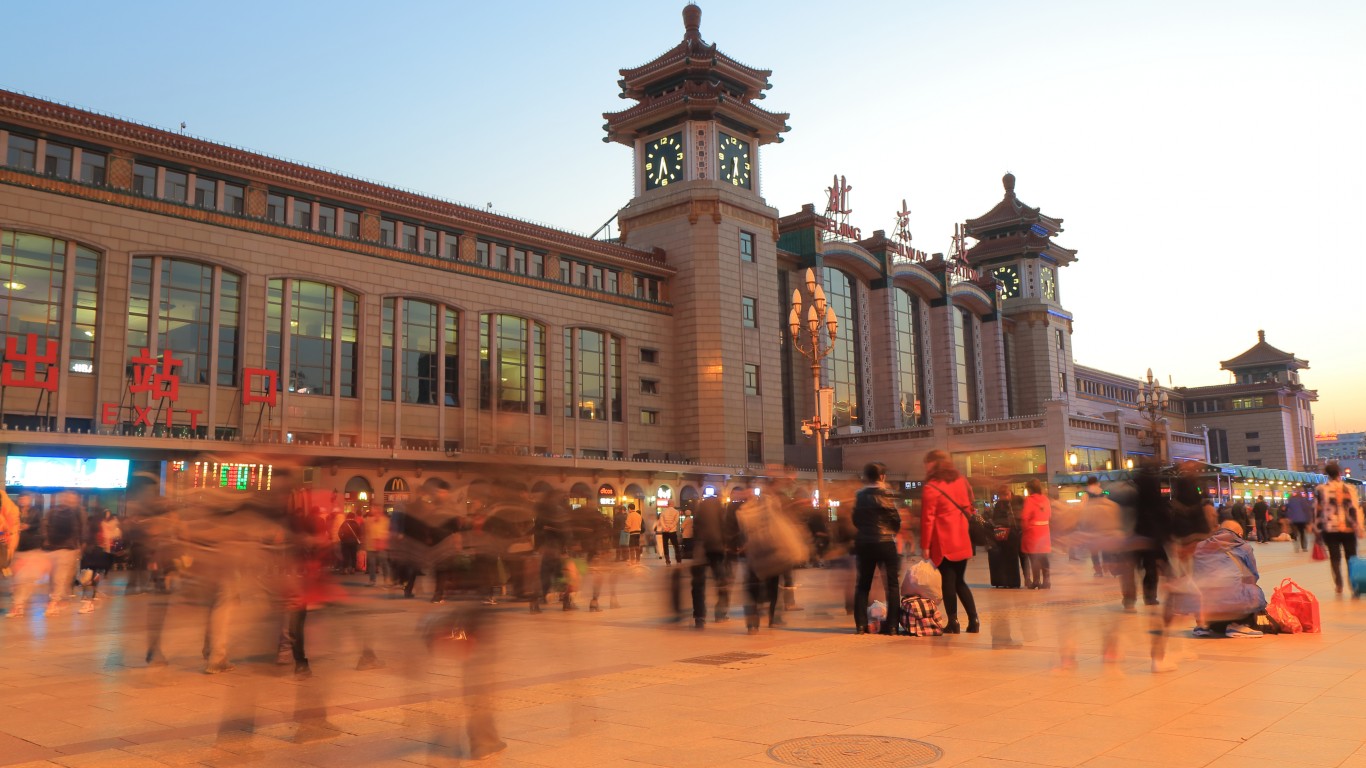
12. Beijing, China
> Population density: 29,827 per square mile
> Population: 8,614,000
> Square miles: 289 miles
Population growth in the Beijing megalopolis comes from a variety of sources, including migrants moving to the nation’s capital in search of opportunity, and the easing of restrictions limiting families to only one child. One of the oldest capital cities in the world, Beijing’s urban problems include air pollution, dealing with domestic waste, and traffic congestion.
[in-text-ad-2]
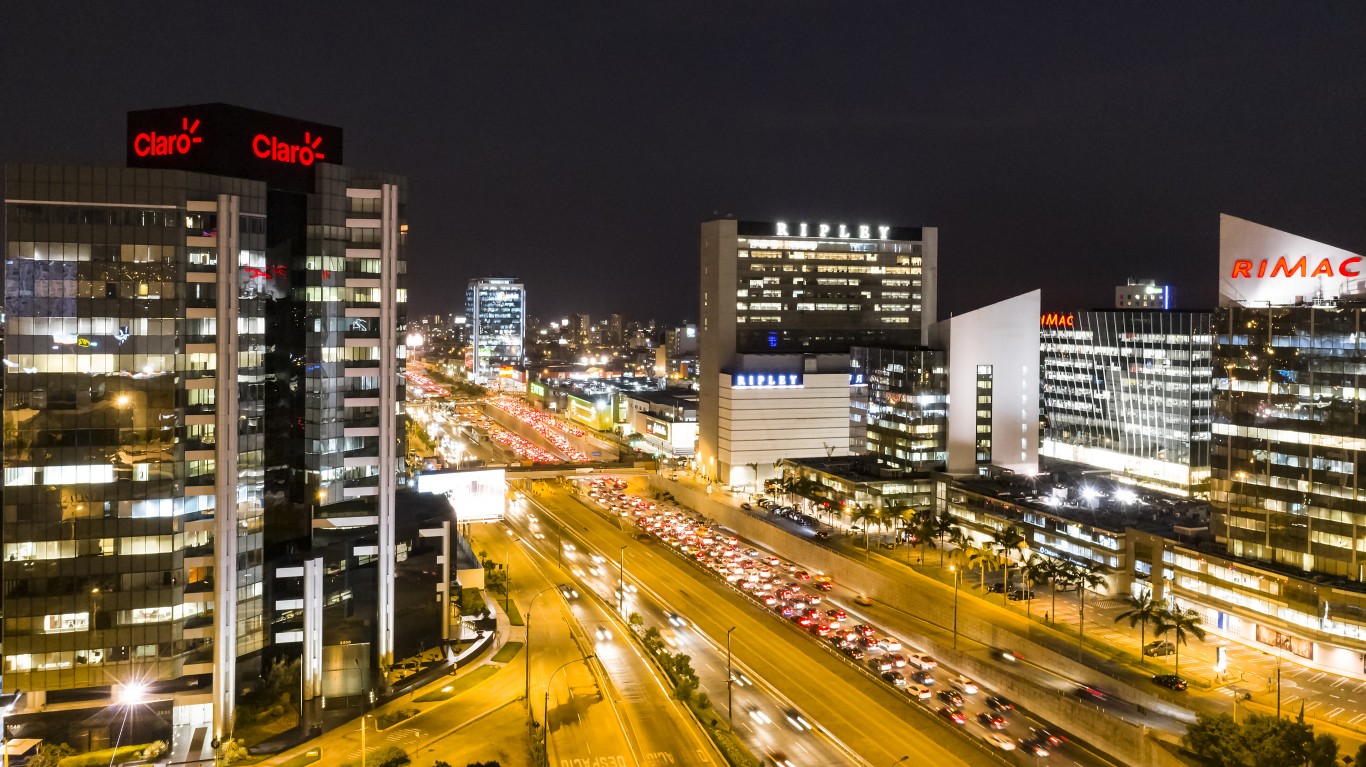
11. Lima, Peru
> Population density: 30,419 per square mile
> Population: 7,000,000
> Square miles: 230 miles
The densely populated Lima is the financial and industrial hub and capital city of Peru. Fishing and mining (gold, copper, zinc and lead) are among the region’s main businesses. Manufacturing and tourism are other revenue generators. Lima will be in the spotlight this summer as it hosts the 2019 Pan American Games.

10. Shanghai, China
> Population density: 34,718 per square mile
> Population: 10,000,000
> Square miles: 288 miles
For more than two decades, Shanghai has been among the fastest growing urban areas in the world. Migration is behind much of the population expansion, with people from other regions of China flocking to the area. Shanghai is the world’s busiest container port; major industries include financial services, tech, wholesale and retail, real estate, transportation, construction, and manufacturing.
[in-text-ad]
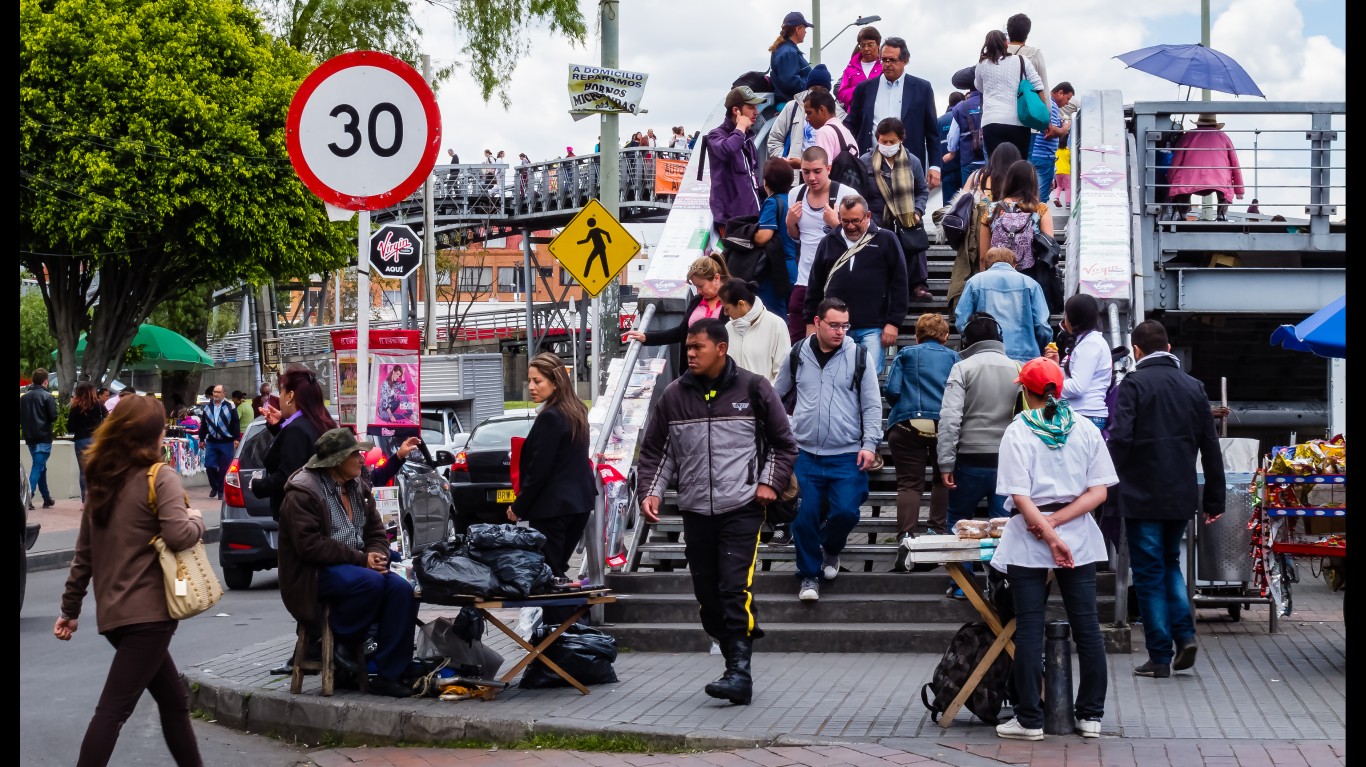
9. Bogota, Colombia
> Population density: 35,000 per square mile
> Population: 7,000,000
> Square miles: 200 miles
Located at more than 8,000 feet above sea level, Bogota is among the highest capital cities on Earth. The country’s center of government and industry, Bogota is aiming to become one of the greenest cities on the continent. A member of the World Green Building Council for the past decade, Bogota has tightened its building codes, made a priority of reducing greenhouse gas emissions, and improving sustainability.

8. Chennai, India
> Population density: 37,223 per square mile
> Population: 5,950,000
> Square miles: 160 miles
The capital of Tamil Nadu state, Chennai is a governmental, industrial and cultural center in southern India. Much of the growth in the megalopolis is from migrants moving from rural areas in the state in search of jobs, though Chennai is also a destination for people from throughout the nation. In recent weeks the region has faced a water shortage, as four of the largest reservoirs are virtually dry from lack of rain.
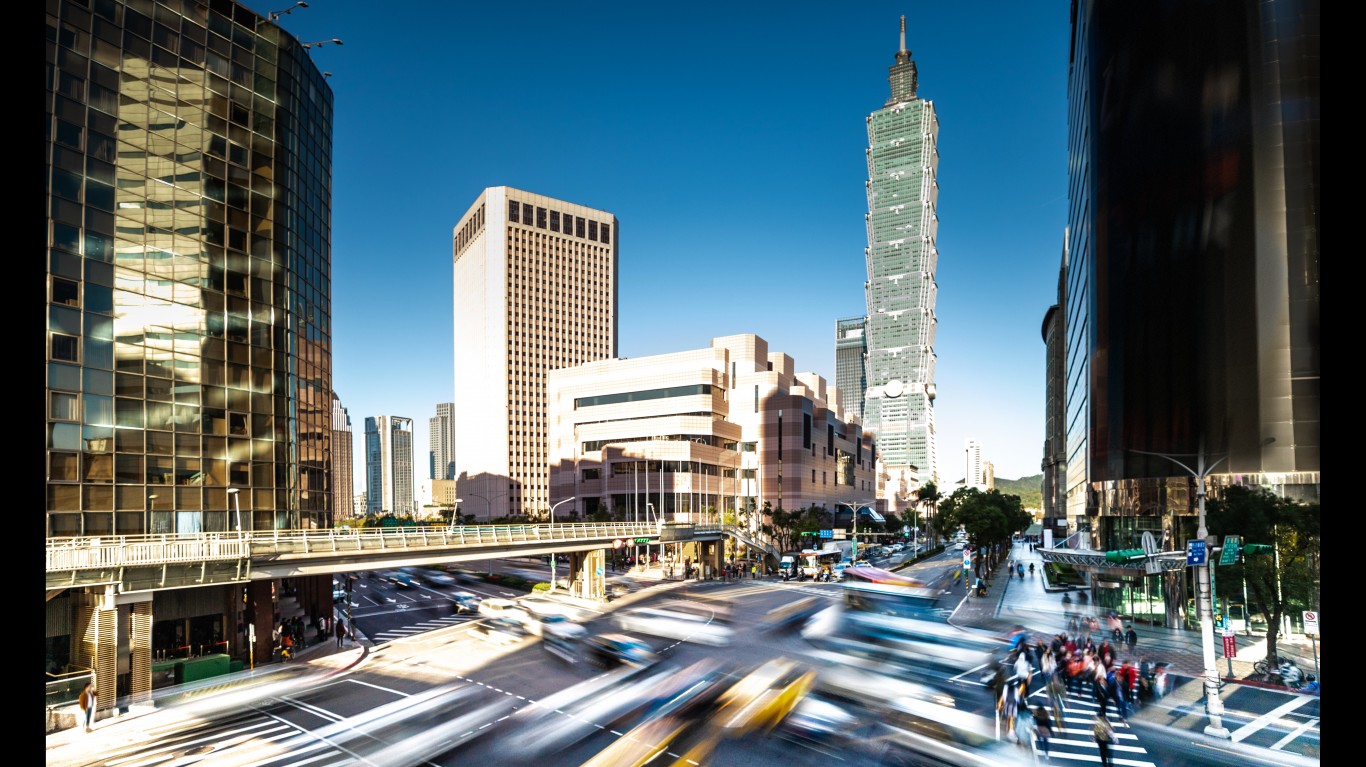
7. Taipei, Taiwan
> Population density: 39,263 per square mile
> Population: 5,700,000
> Square miles: 145 miles
Though there’s no doubt that Taipei is among the most densely populated places on Earth, there’s some concern that the headcount may actually begin to drop. A low birth rate and aging population are fueling fears of a future dwindling workforce and decline in productivity that could slow technical innovation and take a toll on the economy.
Taiwan is the first Asian country to legalize same-sex marriage, and in June, Taipei was the scene of Asia’s largest gay pride parade.
[in-text-ad-2]
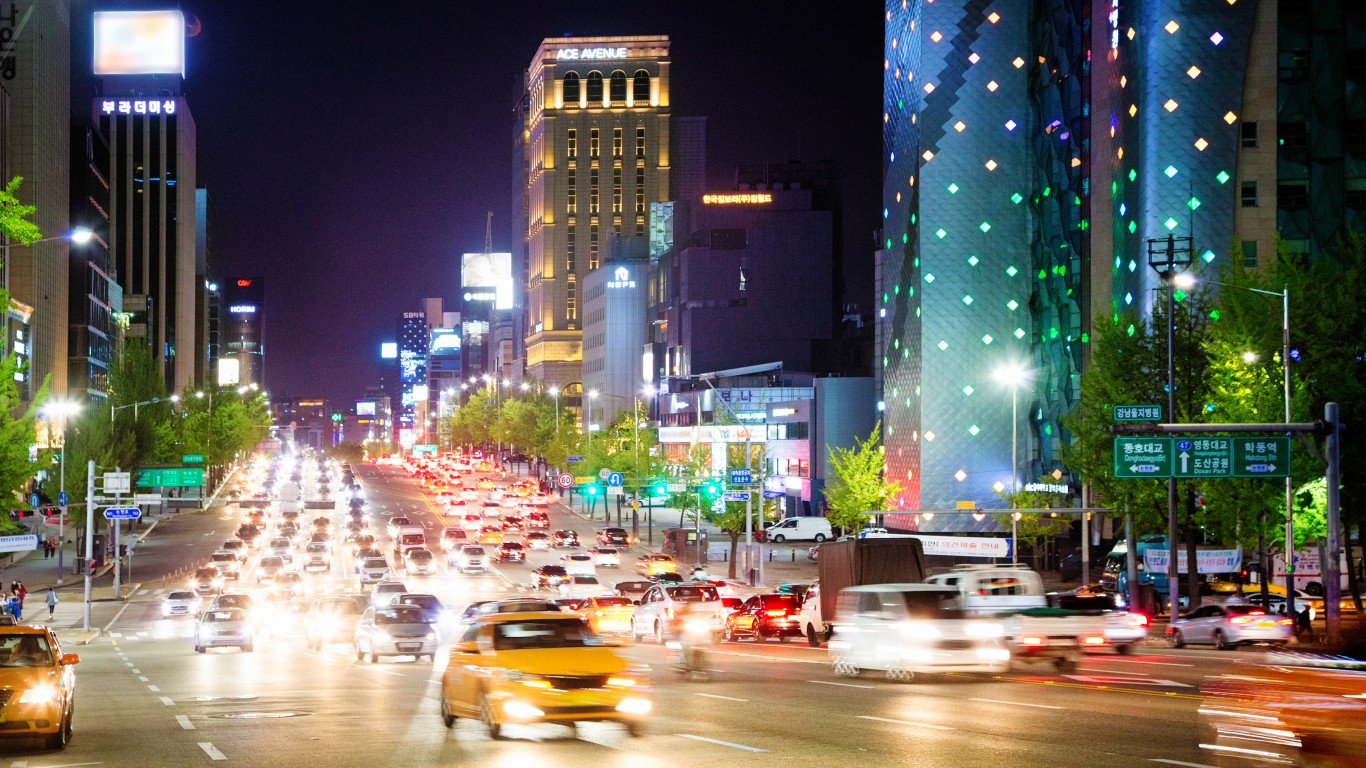
6. Seoul/Incheon, South Korea
> Population density: 43,208 per square mile
> Population: 17,500,000
> Square miles: 405 miles
Low birth rates have caused Seoul’s population growth to level off somewhat. But there’s not likely to be much room to roam in South Korea’s capital for the foreseeable future. The city’s population density is about twice that of New York City and four times higher than that of Los Angeles. The region has the distinction of having one of the best-run airports in the world, Incheon International.
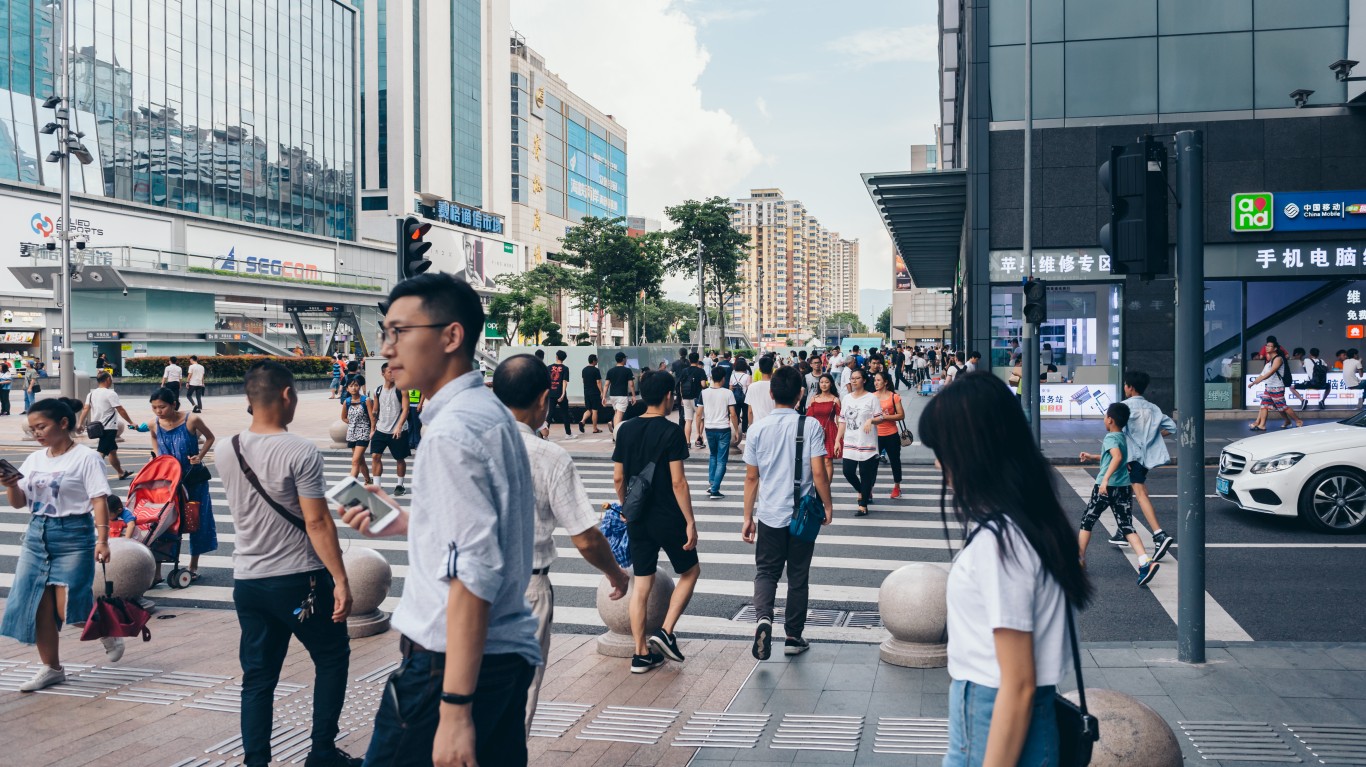
5. Shenzhen, China
> Population density: 44,464 per square mile
> Population: 8,000,000
> Square miles: 180 miles
There are a lot of “mosts” associated with Shenzhen. Though not a capital city, it is the most densely populated region in China. It is also the location of four of the world’s tallest buildings. As of 2017, Shenzhen ranked 6th among cities with the most electric cars on the road. And as of 2017, Shenzhen-based Huawei was 49th on the list of the most valuable brands in the world.
[in-text-ad]

4. Lagos, Nigeria
> Population density: 47,027 per square mile
> Population: 13,400,000
> Square miles: 285 miles
The one-time capital of Nigeria, Lagos is the most densely populated region in Africa. Among the reasons for the overcrowding is the influx of job seekers from rural areas, and refugees from countries like Togo and Cameroon fleeing to the mega-city. The cost of living in Lagos is among the lowest in the world, but the country as a whole has some of the poorest health statistics, including a life expectancy of just over 53 years of age and an infant mortality rate of almost 67 per 1,000 live births.

3. Karachi, Pakistan
> Population density: 49,000 per square mile
> Population: 9,800,000
> Square miles: 200 miles
The former capital of Pakistan, Karachi is the most crowded city in the Muslim world. Migrants and refugees from Bangladesh, Burma, Uganda, Iran and Afghanistan have moved into the area. Migrant workers from other regions of Pakistan add to the density. Though Karachi ranks among the least expensive cities for expatriates, it’s also rated one of the least livable, with a drop in standard of living likely, according to a 2018 study.
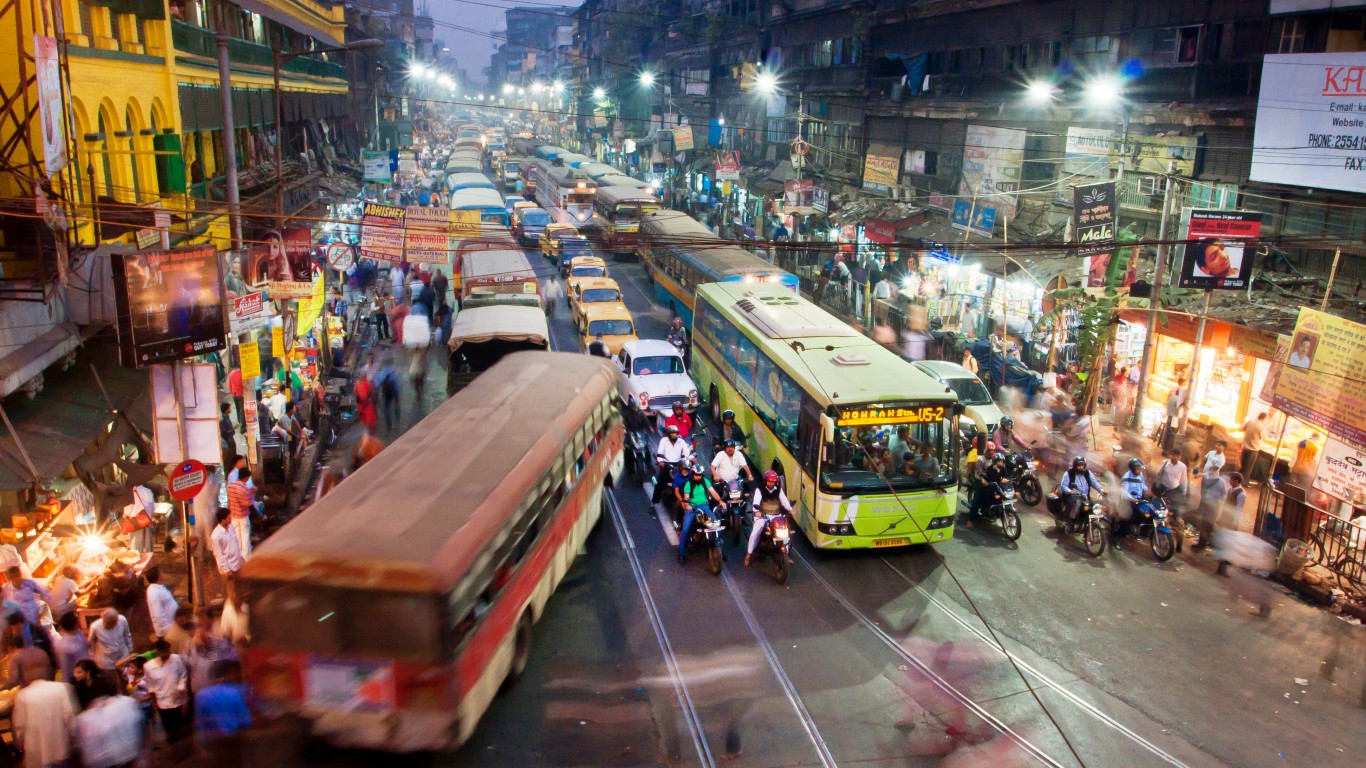
2. Kolkata, India
> Population density: 61,945 per square mile
> Population: 12,700,000
> Square miles: 205 miles
There’s a lot going on in the planet’s second most crowded megalopolis. In addition to being a financial and manufacturing center, Kolkata has a major port and thriving tech sector. Nevertheless, problems with severe air pollution, poverty and infrastructure need to be addressed in the capital city of West Bengal state.
[in-text-ad-2]
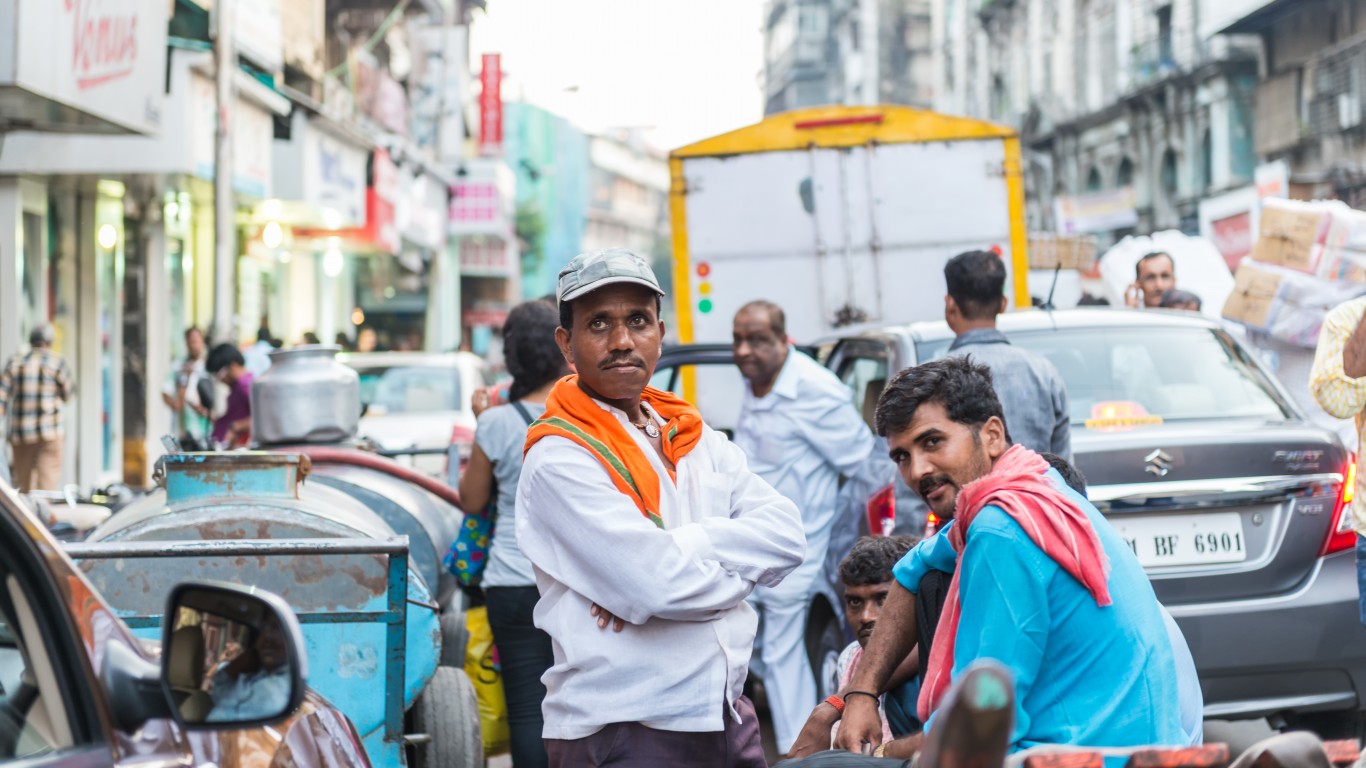
1. Mumbai, India
> Population density: 76,790 per square mile
> Population: 14,350,000
> Square miles: 187 miles
Tens of thousands of people find themselves packed into each square mile of the most crowded urban area on Earth. Regardless of the overall dearth of space, the good life is alive and well in Mumbai, which has one of the greatest populations of mega-millionaires. From traffic congestion to huge landfills to breathtaking architecture, Bollywood movies and urban parkland, Mumbai is a city of contrasts and surprises.
Get Ready To Retire (Sponsored)
Start by taking a quick retirement quiz from SmartAsset that will match you with up to 3 financial advisors that serve your area and beyond in 5 minutes, or less.
Each advisor has been vetted by SmartAsset and is held to a fiduciary standard to act in your best interests.
Here’s how it works:
1. Answer SmartAsset advisor match quiz
2. Review your pre-screened matches at your leisure. Check out the advisors’ profiles.
3. Speak with advisors at no cost to you. Have an introductory call on the phone or introduction in person and choose whom to work with in the future
Get started right here.
Thank you for reading! Have some feedback for us?
Contact the 24/7 Wall St. editorial team.
 24/7 Wall St.
24/7 Wall St.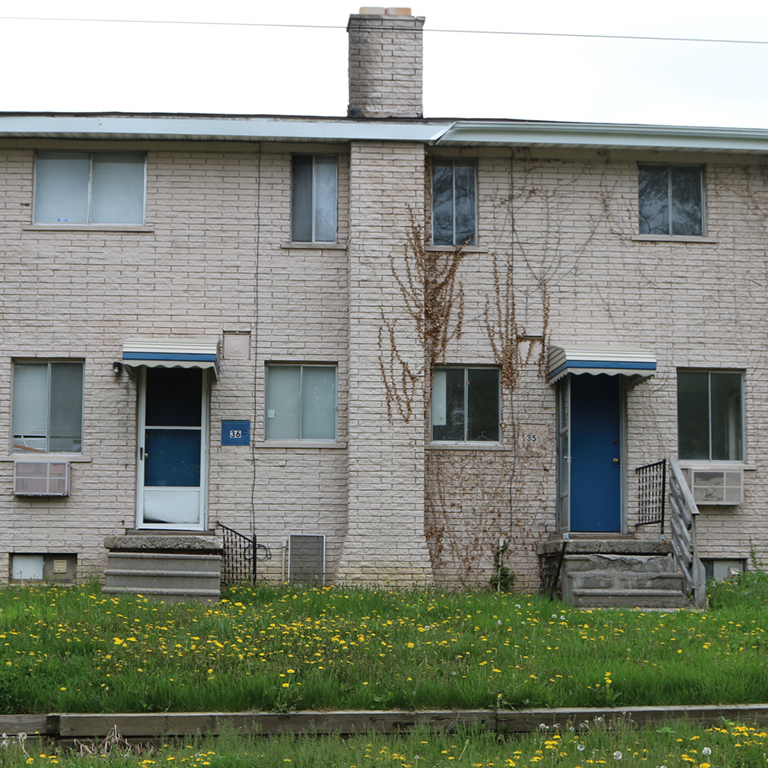 24/7 Wall St.
24/7 Wall St. 24/7 Wall St.
24/7 Wall St.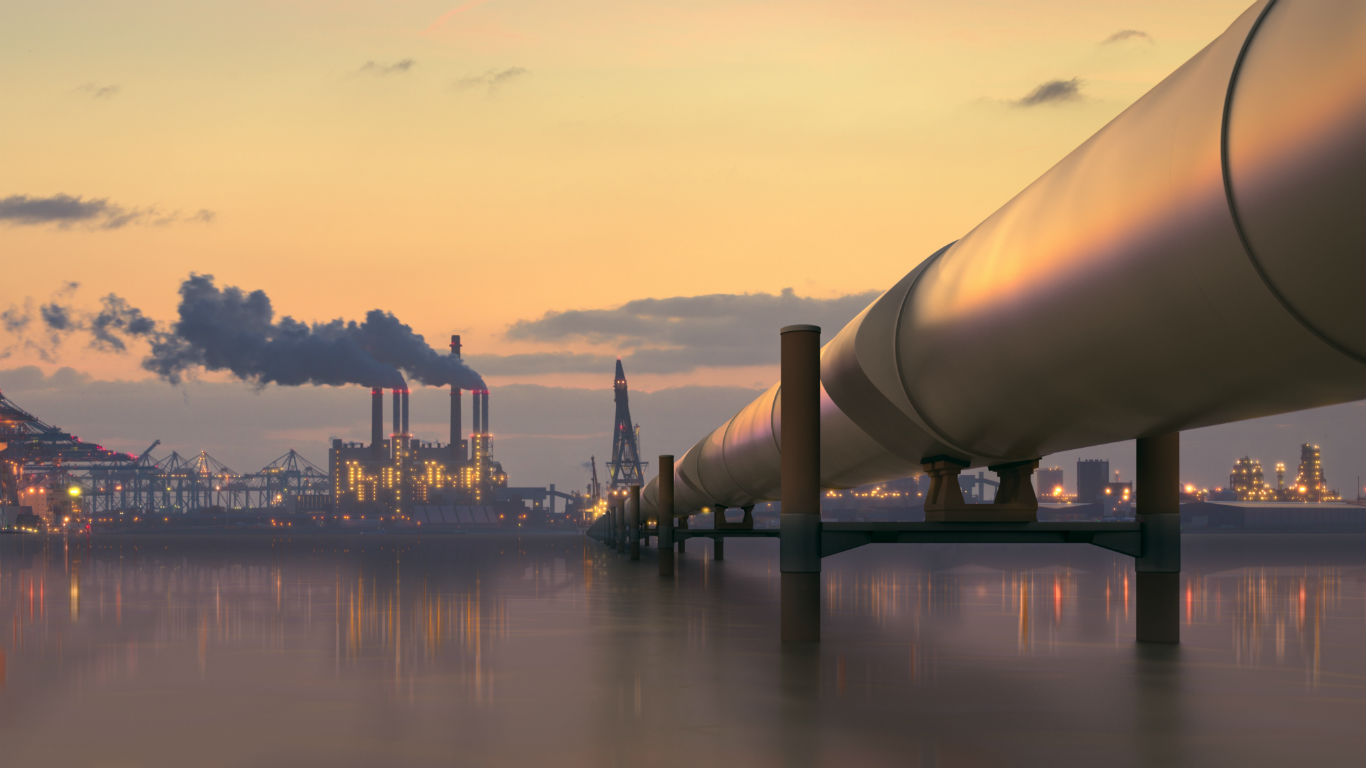 24/7 Wall St.
24/7 Wall St.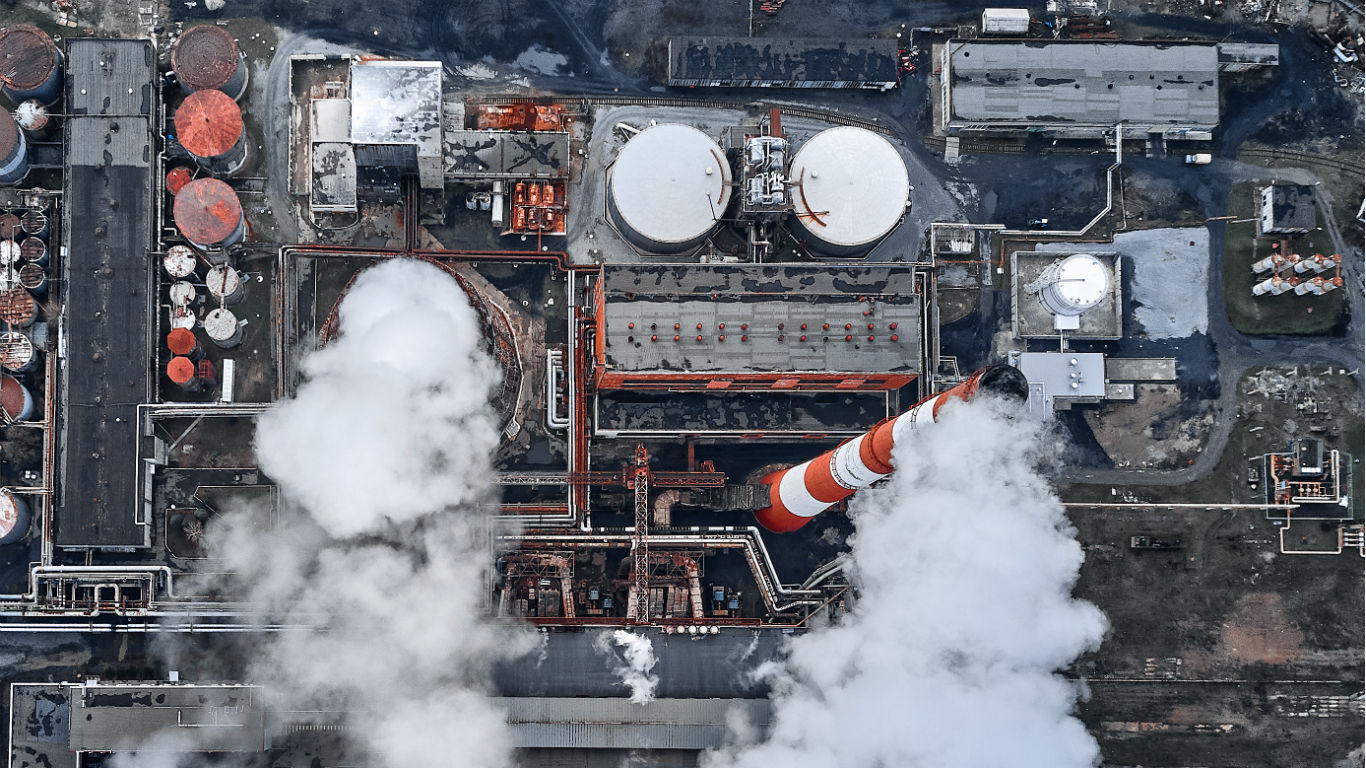 24/7 Wall St.
24/7 Wall St.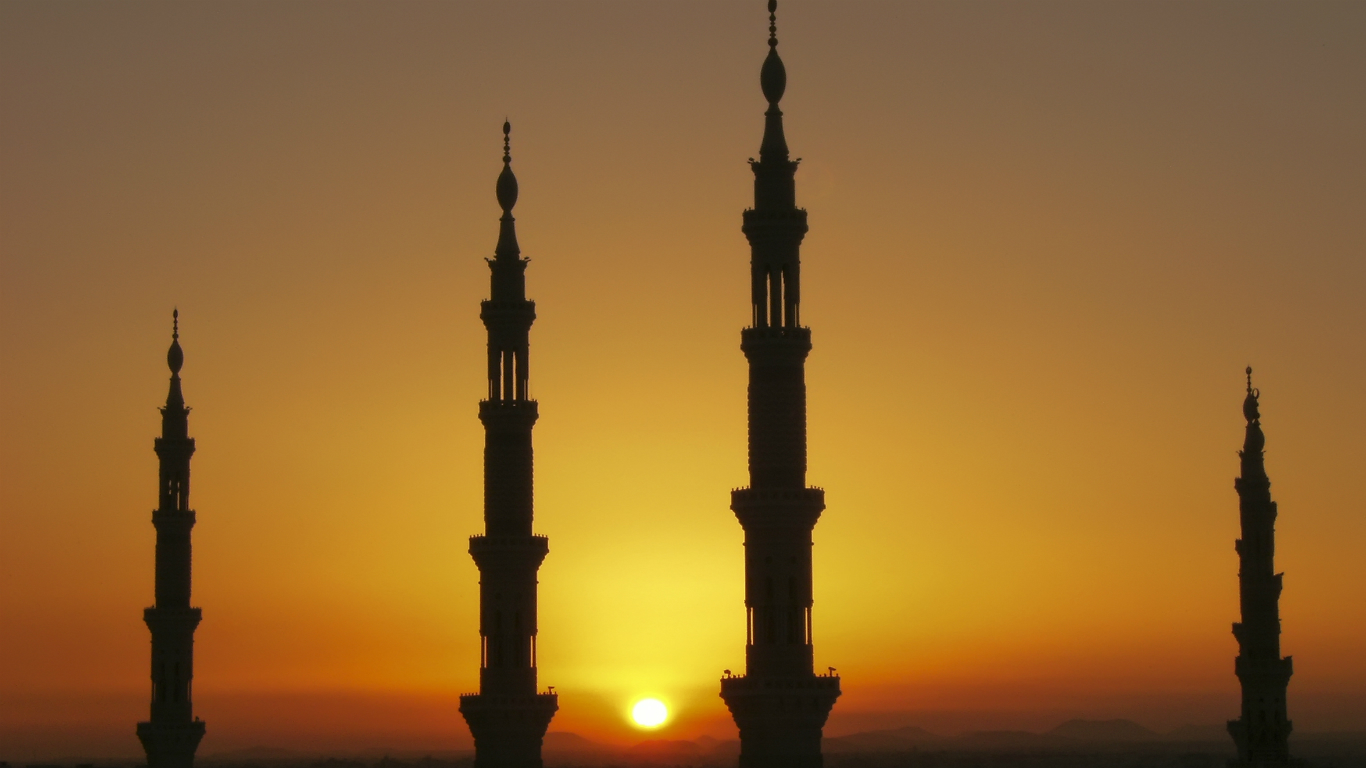 24/7 Wall St.
24/7 Wall St.


